

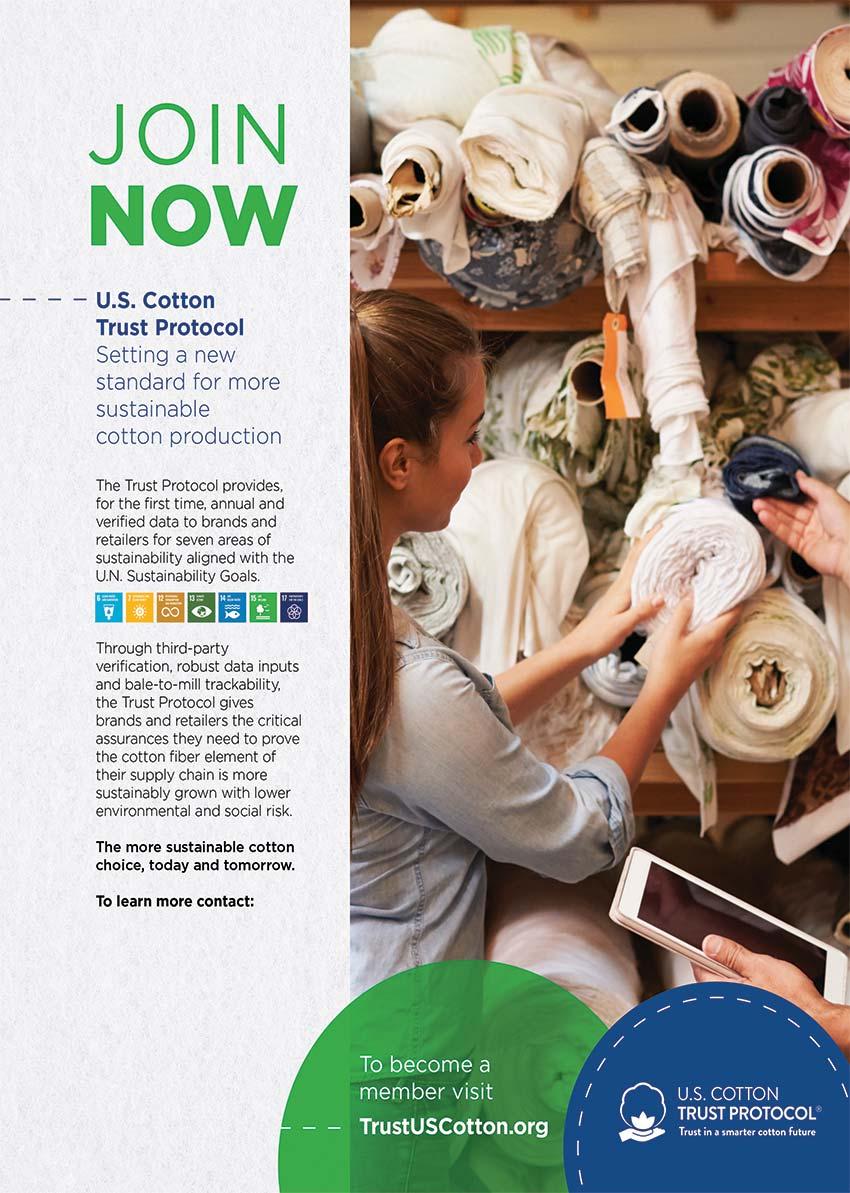
Intertex Tunisia

Dates: October 6th to 8th 2022. Venue: Tunisia.
IGATEX Pakistan 2022, Lahore


Dates: December 1st to 4th 2022. Venue: Expo Centre, Lahore.

FESPA 2023
Dates: May 23rd to 26th 2023. Venue: Munich, Germany.




Textile Asia 2022, Faisalabad
Dates: October 29th to 31th 2022. Venue: Quilim Marquee, Canal Road Faisalabad, Pakistan
Textile Asia 2023, Karachi
Dates: March 11th to 13th 2023. Venue: Expo Centre, Karachi.
ITME INDIA 2022
Dates: December 8th to 13th 2022. Venue: India Expo Centre & Mart. Noida, India.
Index 2023
Dates: April 18th to 21th, 2023. Venue: Palexpo, Geneva, Switzerland.

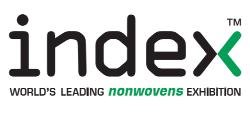

Heimtextil 2023, Frankfurt
Dates: January 10th, to 13th, 2023 Venue: Frankfurt am Main.
JIAM 2022 OSAKA

Dates: Nov. 30th to Dec. 3nd 2022. Venue: Osaka, Japan.
INTEX SOUTH ASIA 2022

Dates: December 8th to 10rd 2022. Venue: New Delhi, India.
DOMOTEX Hannover 2023
Dates: January 12th to 15th 2023. Venue: Hannover, Germany.
ITMA 2023
Dates: June 8th to 14th, 2023. Venue: Milan, Italy.
ITMA ASIA + CITME 2023
Dates: November 19th to 23th, 2023. Venue: NECC, Shanghai, China.
iCADEX Pakistan 2022, Lahore



Dates: December 1st to 4th 2022. Venue: Expo Centre, Lahore.
Istanbul Yarn Fair
Dates: February 16th to 18th 2023. Venue: Istanbul, Turkey.
ITM 2024

Dates: June 4th to 8th, 2024. Venue: Istanbul, Turkey.
DOMOTEX asiaCHINAFLOOR 2023
Dates: May 29th to Sep. 31st 2023. Venue: NECC, Shanghai, China.
HIGHTEX 2024
Dates: June 4th to 8th, 2024. Venue: Istanbul, Turkey.
2 Calendar of Events
PAKISTAN TEXTILE JOURNAL - October 2022

Founded in 1951 by Mazhar Yusuf (1924-2009)
Publisher
Nadeem Mazhar
Editor in Chief Amina Baqai
Associate Editor
Dr. Noor Ahmed Memon
Associate Editor
Nimrah Nadeem
Associate Editor
Shahnawaz Khan
Production Manager Mazhar Ali
Hony-Editorial Board


Dr. Hafizur Rehman Sheikh Ph.D (UK) F.T.I. (UK)
Syed Mahfooz Qutab C.TEX, F.T.I (U.K), B.Sc. Fellow I.C.T.T Atlanta, GA; (USA)
Mian Iftkhar Afzal B.S.N.C State, M.Sc. (Leeds) C.TEXT.F.T.I (UK)
Dr. Zubair Bandukda PhD (Textiles), CText ATI

Editorial & Advertising Office B-4, 2nd Floor, 64/21, M.A.C.H, Miran M. Shah Road, Karachi - Pakistan Tel: +92-21-34311674-5 Fax: +92-21-34533616 Email: info@ptj.com.pk URL: http://www.ptj.com.pk

PTJ Europe Ltd.
Correspondence & Mailing address: 93 Fleming Place, Bracknell, RG12 2GN, United Kingdom Tel: +44 792 2228 721
Registered Office: Dairy House, Money Row Green, Holyport, Maidenhead, Berkshire, SL6 2ND, UK
Registered no. 09141989
Available on Gale and Factiva affiliated international databases through Asianet Pakistan

Printed at: Color Plus Korangi, Karachi.
Published by Nadeem Mazhar from D-16, K.D.A. Scheme No.1. Karachi.
Vol. LXXI No. 10 October 2022 Rs. 565.00
EDITOR’S PAGE . . . . . . . . . . . . . . . . . . . . . . . . . . .7
Higher costs of doing business and uncertainty are not conducive to the textile industry
TEXTILE BRIEFS . . . . . . . . . . . . . . . . . . . . . . . . . . .8
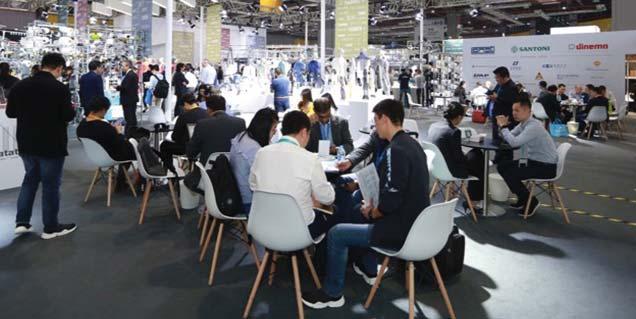





NEWS & VIEWS . . . . . . . . . . . . . . . . . . . . . . . . . .10


AROUND THE WORLD . . . . . . . . . . . . . . . . . . . . . .14
CORPORATE NEWS










Hong Kong Polytechnic University announces the establishment of the school of Fashion and Textiles . . . . . . . . . . . . . . . . . . . . . . . . . . . . . . . . . . . . . . . . .18
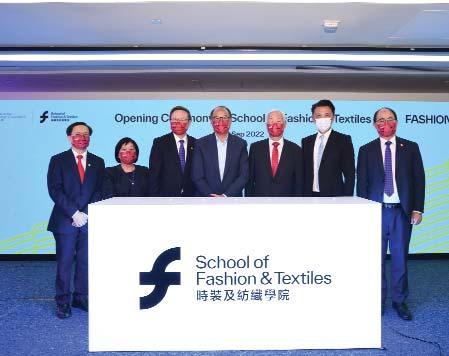
James Heal celebrates its 150th anniversary . . . . . . . . . . . . . . . . . . . . . . . . .20
Rieter expands service footprint in Kahramanmaraş, Turkey . . . . . . . . . . . . . .22
ExxonMobil expands product portfolio to advance healthcare solutions . . . . . . . .24
Dysin Group inaugurates new plant for Specialty Polymer in Gazipur . . . . . . . .26
20 18
28 FAIRS AND EXHIBITIONS ITMA ASIA + CITME 2022 rescheduled to November 2023 . . . . . . . . . . . . . . . . . . . . .28 India ITME 2022 at new world class Venue – IEML, Greater Noida . . . . . . . . . . . . . . .29 PERSONALIA Trützschler Group SE expands Board of Directors . . . . . . . . . . . . . . . . . . . . . .27
FEATURES



INTERVIEW
DYEING, PRINTING AND FINISHING




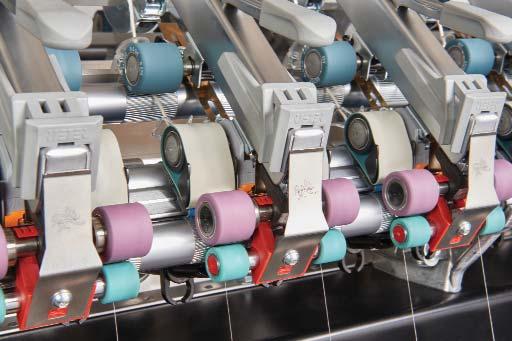
30 32 36 50
Accotex: Field tests confirm high performance of new Accotex aprons . . . . . . . . .30 LYCRA announces collaboration with Qore® to use QIRA® for Bio-Derived LYCRA® .32 World Cotton Day: Challenges for Pakistan’s cotton industry . . . . . . . . . . . . . .34 Suessen: Economical Compact-Spinning using state-of-the-art technology . . . . . . .36 Loepfe YarnMaster® PRISMA100% color monitoring leads the way! . . . . . . . . . . . .38 38 46 42
Swiss Textile Manufacturing – 30 years of sustainable progress . . . . . . . . . . . . .40 Cotton Council International celebrates its third Cotton Day in Mumbai . . . . .42 A World without odors, Fight or Flight? . . . . . . . . . . . . . . . . . . . . . . . . . . . . .44
SPECIAL REPORTS
Unique waxed cotton finishing with new Monforts line . . . . . . . . . . . . . . . . . .50 AQUARIA® offers limitless potential for after-printing washing process . . . . . . .52 BRÜCKNER Textile Technologies & HEATHCOAT FABRICS – the journey continues . .54 Demsan - Leading manufacturer of textile machine . . . . . . . . . . . . . . . . . . . .56 Jeanologia empowers a new generation of tech artisans at DenimandJeans Japan . .58 Makroser Tekstil’s carpet production soars with a Mimaki TS300P-1800 . . . . . .60 Tonello: New O-Zone cabinet . . . . . . . . . . . . . . . . . . . . . . . . . . . . . . . . . . . .62 58
Stäubli creates new benchmarks with high-performance textile machinery . . . .46
Mr. Fritz Legler – Division Marketing Officer, Stäubli Textile
Interview:

Higher costs of doing business and uncertainty are not conducive to the textile industry


The Pakistani rupee witnessed a record decline in July 2020 when PKR traded above 240 to the dollar. This was over 35% depreciation of the Rupee against the USD since November 2021. While the PKR has witnessed a slight recovery since then, Pakistan is facing unemployment, high-interest rates and record inflation as a result of political and economic uncertainty due to internal and global factors including the war in Ukraine. As Pakistan is a net importer of fertilizers, oil, food items, machinery, and many raw materials, under the current scenario, the prices of commodities are increasing at a high pace due to the increase in the prices of imported goods.
The PKR depreciation has significantly increased the cost of doing business and will adversely affect Pakistan’s competitiveness in the international market. The first consequence of a depreciated Rupee logically would be an expected increase in exports. That expected surge in exports is not forthcoming due to the global recession and the highest inflation Pakistan has witnessed in decades.
The PKR depreciation is forcing Pakistan’s Gross Domestic Product (GDP) towards a downfall due to the higher cost of imported goods and increased exports at lower prices. The economy is suffering due to the imbalance between imports and exports.
Pakistan’s textiles had fared extremely well compared to other countries when dealing with the Covid19. During that period 2020 to 2021, Pakistan’s exports witnessed record growth and the industry buoyed by the great performance made good use of the favourable financial incentives by investing more than $5 billion (Rs1 trillion) in setting up new factories to meet their export commitments.

According to Mr. Shahid Sattar, Secretary General APTMA, some of these installations were now complete while the others are in the process. Due to the extraordinary decline in the foreign exchange reserves, some of the machinery of new plants/expansions was still stuck at ports, as letters of credit were being delayed. Also, electricity and gas are not being provided to these new units.
“If remedial action is not taken on non-functionality of this new investment; then instead of increasing exports by $5 billion per annum, it will likely lead to massive banking defaults, and complete loss of investor confidence in future for any investment in Pakistan with many other negative consequences,” Sattar said.
SBP has now stated that imports under Chapters 84-85 would be released. However, only direct exporters, whereas indirect exporters were neglected, these exporters keep the industry running. The intermediate goods exports are now suffering and will drop over time as this will result in the shutting down of mills due to lack of maintenance and availability of vital spare parts.
Pakistan also needs to import at least 5 million cotton bales this fiscal as well due to recent flood damages to the cotton crop. Flood-related losses to the cotton crop are currently estimated at 3.5 million bales, or 36 per cent of the anticipated harvest this year amounting to a total loss of over $1 billion.
Urgent policy measures by the government are required to arrest the decline in the industrial sector due to a multitude of economic issues faced by the country.
7 EDITOR’S PAGE
1951 October 2022 Dyeing, Printing and Finishing II
Established
October 2022
1The clothing and textile sector in Pakistan is anticipating a drop of at least 30% in the value of exports after the recent floods wiped out much of the country’s usually plentiful cotton crop, and the sector is seeking out strategies to buy cheaper cotton abroad.
2Effective from October 2022, the government has decided to discontinue the concessional tariff given to consumers of export oriented sectors. According to an official memorandum issued by the ministry of energy, the concessional tariff scheme to consumers of the export-oriented sector will be discontinued with effect from October 1, 2022.
3Pakistan’s textile exports have increased 6.37 per cent to $1.57 billion in August 2022 compared to last month’s $1.48 billion exports, with all major components – cotton cloth, knitwear, bedwear, towels, and readymade garments –showing growth. Textile exports were up 7.7 per cent over August 2021 exports of $1.46 billion, the Pakistan Bureau of Statistics (PBS).

4The Pakistan Hosiery Manufacturers and Exporters Association (PHMA) North Zone has elected Naseer Butt as its new zonal chairman for the period of one year 2022-23.
5Pakistan's Finance Minister has said that the country's textile sector had demanded the lifting of a ban on the import of cotton from India, but the government has so far not taken any decision on the issue.
6Asif Inam, Chairman, APTMA – Southern Zone urges the government for allowing the immediate release of textile machinery and spare parts that were stuck up due to restrictions on the import of items covered under Chapters 84 and 85 of the Customs Tariff.
7The Ministry of Finance and the Federal Board of Revenue (FBR) have
agreed to clear Rs 36 billion in deferred sales tax refunds of the textile sector in 32,000 cases pending since 2019. The decision to this effect was taken during a meeting of the Finance Minister with a delegation of the All Pakistan Textile Exporters Association (PTEA).
8Irfan Iqbal Sheikh, President, Federation of Pakistan Chambers of Commerce and Industry (FPCCI), the apex trade body of Pakistan urged the government has urged that the government to reintroduce the regime of fixed exchange rate and stop latest cycle of devaluation of the Pakistani Rupee (PKR) against the US dollar.
1The BGMEA recently urged investment in the country’s readymade garment sector as it gears up for graduation from its status as a least developed country (LDC). The country is expected to graduate from LDC status in 2024.
2Textile companies in China with an annual primary business revenue of at least 20 million yuan (about 2.89 million U.S. dollars) raked in 2.96 trillion yuan in revenue in the period, up 4.6 percent year on year. In this way the industry posted stable revenue growth in the first seven months of the year.
3Tajikistan's cotton exports to Uzbekistan vastly increased from January through June 2022. According to the statistics, cotton exports from Tajikistan to Uzbekistan in the reporting period amounted to $17.3 million.
4Bangladesh is an emerging star in the global textile industry as it has succeeded in converting itself into a global factory for textile products. Bangladesh apparel exports touched $42.61 billion during last fiscal 2021-22 (July-June).
5The 2022 revenue of the Italian fashion and luxury industry as a whole, including textiles, leather goods, apparel,
footwear, jewelry, beauty products and eyewear, is expected to reach Euro 92 billion, up 10.5% over 2021
6Japan’s imports of clothing and accessories increased by 47.3 per cent year-on-year to 400,348 million yen (approximately $2,791 million) in August 2022.
7The India International Textile Machinery Exhibition Society (ITME) has signed a Memorandum of Understanding (MoU) with Kenya National Chamber of Commerce and Industry (KNCCI), aimed at building new opportunities for growth in the industry.
8According to reports, the exports of the Turkish textile and raw materials sector increased by 7.5% in the January-August 2022 period compared to the same period of the previous year and reached 8,8 billion dollars.


9
Cotton exports from the US witnessed a steep fall to $28.362 million in July 2022 from $1,062.592 million in June 2022.
10Many textile and garment enterprises in Vietnam are seeing a sharp drop in export orders, mainly in the US and EU, because inflation pressure in these nations is large, forcing consumers to tighten spending.
8 PAKISTAN TEXTILE JOURNAL - October 2022
Textile Briefs National
Textile Briefs International

The clothing and textile sector in Pakistan is anticipating a drop of at least 30% in the value of exports after the recent floods wiped much of the country’s usually plentiful cotton crop, and the sector is seeking out strategies to buy cheaper cotton abroad.
Textile and garment exports from Pakistan amounted to US$21bn in the fiscal year 2021-22, said the All Pakistan Textile Mills Association (APTMA), but now, due to the devastation caused by flooding, industry experts fear a probable cancellation of many export orders by international brands.
With more than 40% cotton production in Sindh province, southern parts of the Punjab province and parts of Balochistan inundated, the APTMA and other industries fear the textile and garment exports may fall from shrinking production and increased costs, with APTMA noting this will hit “the government’s vision to achieve the export volume of US$50bn in the coming years”.
With the view to fostering exports and boosting the economy of the country, last month (August) APTMA unveiled a plan to launch a road map to achieve US$50bn in exports by increasing the country’s stitching-focused clothing manufacturing sector to process an additional US$3bn worth of yarn and
fabrics. In this way, it would boost Pakistan’s value-added garments for export, generating an additional income of US$10bn.
The Pakistan Textile Exporters Association has suggested to the country’s federal minister for finance and revenue to allow cotton imports from neighbouring India as it would be cheaper compared to cotton imports from Central Asia countries and other locations. However, the government has yet to take a decision in this direction.
Pakistan urged to add value to textile goods
The US Cotton Council International (CCI) has urged Pakistan to manufacture and export textile goods to America after enormous value-addition. The advice came at a meeting held between the All Pakistan Textile Mills Association (Aptma) and the CCI, with the objective of apprising the body about cotton quality, challenges, and possible solutions vis a vis challenges being faced by Pakistani cotton growers.
“Mutual cooperation between the American cotton growers and Pakistan’s textile industry offers a win-win situation for both countries where raw cotton imported from the US is converted into manufactured textile products and exported back to the US after enormous value addition,” said Kathleen Gibilisco, the Head of the Economic Wing of the US Consulate.
She was accompanying the US’s CCI delegation that called on the Aptma office bearers, emphasised the need for growth and sustainability in trade and economic relations between Pakistan and the US. She expressed hope that the current trend of growth in trade and economic ties would continue in the future as well.
The demand for improved product quality comes at a time when Pakistan is facing a severe shortage of approximately nine million bales this year due to various factors, including the devastation of the agriculture fields largely by floods.
It may be mentioned that Pakistan’s cotton demand continues to rise, as it needs 15m bales this year. The Aptma and CCI representatives resolved to boost bilateral cooperation in the area of cotton and explore investment opportunities in Pakistan.
Dealing with the cotton needs of Pakistan’s textile industry
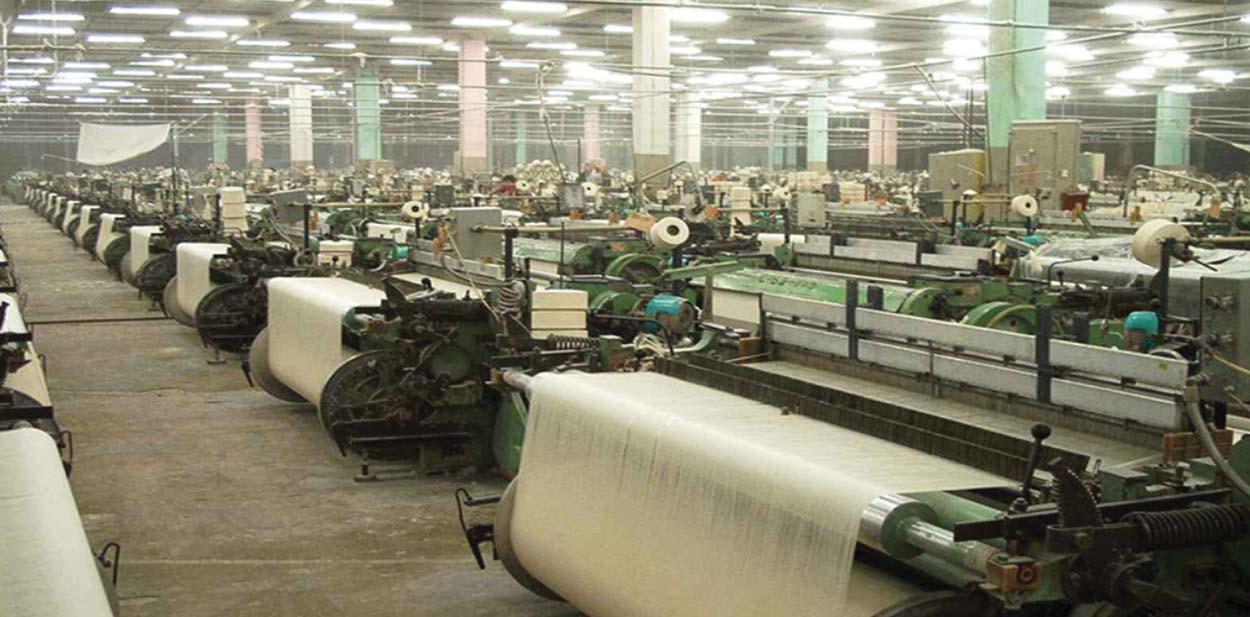
More than 15 percent of Pakistan’s current cotton crop has been destroyed by severe rains and flooding, introducing a high level of uncertainty about the nation’s plans for export shipments. The All-Pakistan Textile Mills Association (APTMA) and the International Cotton Association (ICA) have agreed to strengthen their collaboration on the cotton needs of Pakistan’s textile industry.
Speaking at the event, APTMA chairman Rahim Nasir offered the
Pakistan garment exports could decline by 35% due to flooding
PAKISTAN TEXTILE JOURNAL - October 2022 10
APTMA facilities for the ICA training session. He also requested the ICA to establish an office on the APTMA grounds for better coordination, with the soaring need for cotton in the coming years.
Cotton, he added, is an important cash crop for Pakistan and a major raw material for its textile sector, accounting for 75 percent of the fiber mix in textile industry products, which provide a living for 25 million Pakistanis.

Chairman APTMA stated that cotton production in Pakistan has plummeted to less than 8 million bales this year, compared to a projected consumption of 13 million bales, due to water shortages, fake pesticides, and poor insect management. He noted that, when combined with other fundamental issues, the cotton import bill in FY022 has risen to roughly $1.8 billion.
He stated that Pakistan is becoming a cotton importing country, but importers are unaware of the ICA rules and their rights as buyers.
Textiles exports increase 6.37pc in Aug 2022
Pakistan’s textiles exports have increased 6.37 percent to $1.57 billion in August 2022 compared to last month’s $1.48 billion exports, with all major components – cotton cloth, knitwear, bedwear, towels, and readymade garments – showing growth.
Textile exports were up 7.7 percent over August 2021 exports of $1.46 billion, the Pakistan Bureau of Statistics (PBS). From July to August, the textile sector’s total exports increased by 4.2 percent to $3.056 billion from $2.93 billion the same period last year.
In August 2022, cotton cloth exports increased 7.37 percent to $195.4 million compared to $182 million in July 2022, while compared with August 2021, exports rose 3.8 percent from $188.2 million.
Over the previous month, knitwear exports increased 3.4 percent to $450 million; bedwear 1.7 percent to $258 million; towels were almost stagnant at $75 million; exports of readymade garments went up 8.35 percent to $330 million, whereas cotton yarn sales abroad increased 24.8 percent to $89.1 million.
Likewise, over the corresponding month of last year, cotton cloth exports were up 3.8 percent, knitwear 23.6 percent, and readymade garments 16.3 percent. However, over August 2021, exports of bedwear slashed 2.44 percent, towels 9.4 percent, and cotton yarn exports declined 14 percent.
In FY22, total textile exports were at a historic high of $19.35 billion, with an increase of over a quarter over FY21’s exports of $15.4 billion. Textiles is the top foreign exchange earner for Pakistan and occupies over 60 percent of the country’s total exports.
In August 2022, the economy imported 6.5 percent more machinery and it stood at $668.4 million against $627.6 million in July. In August 2021, its imports were
984.8 million. Textile machinery imports increased 49 percent to $55.86 million, power generation machinery went up 21.9 percent to $54.6 million, and telecom sector machinery increased by 49.5 percent to $101.5 million. However, electrical machinery imports were down 19.6 percent to $195.2 million and construction machinery imports declined 14 percent to $6.5 million.
It is to be noted that in August 2022, the country’s total exports were $2.482 billion as compared to $2.254 billion in July 2022, showing an increase of 10.12 percent and 10.46 percent as compared to $2.247 billion in August 2021. In JulyAugust 2022, exports totalled $4.737 billion against $4.587 billion during the corresponding period of last year showing an increase of 3.27 percent.
Total imports in August 2022 were recorded at $6.07 billion as compared to $4.993 billion in July 2022 showing an increase of 21.59 percent but a decrease of 7.69 percent as compared to $6.577 billion in August 2021. During JulyAugust 2022, total imports were $11.064 billion as against $12.152 billion during the corresponding period of last year showing a decrease of 8.95 percent.
Factories making towels and Bedsheets are facing difficult times
Pakistan’s small textile mills, which make products ranging from bedsheets to towels mainly for consumers in the US and Europe, are starting to shut after devastating floods wiped out its cotton crop.
As many as 100 smaller mills have suspended operations due to a shortage of good quality cotton, high fuel costs, and poor recovery of payments from buyers in flood-hit areas, said Khurram Mukhtar, patron-in-chief of the Pakistan Textile Exporters Association. Larger firms, which supply to global companies like Nike Inc., Adidas AG, Puma SE, Target Corp., are less affected as they are well stocked, he said.
The mill closures underscore challenges for the sector that employs about 10 million people, accounts for 8% of the economy and adds more than half to the nation’s export earnings. Their hardships have become acute due to
recent floods, which submerged a third of Pakistan, killed more than 1,600 people, and damaged about 35% of the cotton crop.
The latest blow comes at a difficult time for the South Asian nation that is already struggling with high inflation and falling currency reserves. The closure of firms, such as AN Textile Mills Ltd., Shams Textile Mills Ltd., J.A. Textile Mills Ltd. and Asim Textile Mills Ltd., could worsen the country’s employment situation and hit its export earnings. Larger companies are also facing rough weather, with demand for their products seen falling about 10% by December from now due to a slowdown in Europe and the US, Mukhtar said.
Due to an “unforeseen downturn in the market and unavailability of good quality cotton” following heavy rains and floods, the company’s mills have been temporarily closed.
Cotton production in Pakistan could slump to 6.5 million bales (of 170 kilograms each) in the year that started in July, compared with a target of 11 million, Mukhtar said.

That could force the nation to spend about $3 billion to import cotton from countries such as Brazil, Turkey, the US, East and West Africa and Afghanistan, said Gohar Ejaz, patron-in-chief of All Pakistan Textile Mills Association. About 30% of Pakistan’s textile production capacity for exports has been hampered because of cotton and energy shortages, Ejaz concluded.
Pakistan yet to decide on lifting of ban on cotton import from India
Pakistan's Finance Minister has said that the country's textile sector had demanded lifting of a ban on the import of cotton from India, but the government has so far not taken any decision on the issue.
Addressing a press conference along with Defence Minister Khawaja Asif, the Finance Minister talked about the damage caused to the cotton crop due to devastating floods that have affected more than 33 million people, inundated a third of the country and caused losses of more than USD 10 billion.
Replying to a question with respect to trade with India, the minister said that the All Pakistan Textile Mills Association (APTMA) was asking the federal government to allow import of cotton from India.
"The government has not taken any decision yet," he said, without elaborating when such a decision could be taken.
Pakistan suspended trade with India after the latter revoked the special status of Jammu and Kashmir in August 2019. But the ban is hurting the crisis-hit country in the wake of floods which caused scarcity of commodities and pushed up prices.
PAKISTAN TEXTILE JOURNAL - October 2022 12 News & Views
Pakistan cotton prices surge due to flood devastation
Cotton prices in Pakistan have surged sharply over the past few days as major floods destroyed the cotton crop. According to analysis, local cotton prices have traded up over the past month, increased by 24 per cent to Rs22,506 per 40-kg, having reached a recent high of as much as Rs24,649/40-kg on August 27, 2022.
The sharp uptick in prices was driven by expectations of supply-side constraints in the cotton market in the aftermath of the floods that left one-third of the country submerged in water.
According to latest estimates from the UN, about 3.6 million acres of crop land has been destroyed in the floods, with the majority of the devastation concentrated in Sindh (2.9 million acres affected).
In a recent address, Finance Minister Miftah Ismail pointed towards all of the cotton crop in the province of Sindh having been damaged by the floods –indicating that about 30 per cent of the national cotton crop has been lost. Resultantly, Pakistan is expected to meet the supply shortfall by importing cotton of $1.5-2 billion,
Latest data released by Pakistan Cotton Ginners Association (PCGA) showed that cotton arrivals in the ginners were down by 0.25 million bales when compared to the same period last year, with 1.54 million bales having reached by September 2022. The slump was largely driven by a shortfall in Sindh, where 0.84
million bales arrived at the ginners, lower by 0.4 million bales or 33 per cent year on year.
The prices have, however, eased from a high of USc173/lb reached in May 2022. Higher prices in the international arena are being driven by adverse climate conditions across the globe, with India suffering from heavy rains and pest attacks, while the US has experienced a drought in the cotton-growing region of Texas (the state has experienced the second driest year in 128 years so far this year).
To note, the US accounted for 33 per cent of total cotton shipments in FY22, and the US Department of Agriculture estimates 66 per cent of the cotton producing area has been experiencing a drought.
Moreover, the US has downward revised the global output for FY23 by around 3 million bales in recent WASDE reports, with the output now expected at 117 million bales.
PHMA elects its Zonal Chief
The Pakistan Hosiery Manufacturers and Exporters Association (PHMA) North Zone has elected Naseer Butt as its new zonal chairman for the period of one year 2022-23.
The newly-elected zonal chairman, addressing the annual general meeting held recently, said that it was an honour for them to lead the zonal office of the hosiery association for the year 2022-23, paying tributes to the outgoing chairman, saying the outgoing body has been
actively promoting the interests of the value-added textile industry throughout the year. He vowed to continue with their efforts for the promotion and protection of the value-added textile industry.

The PHMA new zonal chairman expressed the confidence that he would make all efforts to work selflessly in resolving issues and problems faced by the industry in the best interests of PHMA members and in further enhancing and boosting the exports.
Butt added that he would accord top priority in respect to reduction in cost of inputs, resolution of refund related issues, and a favourable environment for the promotion of hosiery industry in Pakistan. Growth of value-added textile industry was a must to steer the industry out of worse situation and contribute to the exports of the country. If conducive environment is provided by the government the exports of knitwear sector alone will be enhanced significantly in coming years, he pledged.
Naseer Butt said that the knitwear apparel maintains the highest exports share, remaining at top of exports statistics every year despite adverse factors such as liquidity crunch and high costs of doing business.
He suggested the new body to accord top priority in reduction of input cost, resolution of refund issues and a favourable environment for the promotion of hosiery industry. He said that growth of value-added textile industry was a must to steer the overall economic growth of the country.
13 News & Views
BANGLADESH

Bangladesh’s RMG industry preparing for next phase of growth
The RMG industry of Bangladesh has “immense potential for growth”, Shahidullah Azim, vice president of the Bangladesh Garment Manufacturers Exporters Association (BGMEA) has said, playing a crucial role in propelling the economic development of the country.
Speaking at an event in Dhaka last week, organised by the National Security Intelligence Training Institute (NSITI), Azim said, as a mainstay of Bangladesh’s economic success story, the apparel sector has continued its endeavours to seize every opportunity that lies ahead and contributes to the development of the country.
“The industry is increasingly focusing on product diversification, innovation, technology upgradation and skill development in a bid to enhance its capabilities and competitiveness in the global market in the coming days,” he added.
The BGMEA recently urged investment in the country’s readymade garment sector as it gears up for graduation from its status as a least developed country (LDC). The country is expected to graduate from LDC status in 2024, however, it will continue to benefit from duty-free access to the European Union, Canada, and Japan until 2027.

The country’s growth in recent years has resulted in a decline in poverty levels, stable inflation, moderate public debt, and greater resilience to external shocks.
In his keynote speech last week, Azim gave an overview of Bangladesh’s RMG industry, including its challenges, opportunities, and preparedness to realize its potential. He also briefed the audience about the RMG industry’s future priorities, including upgrading business capabilities and embracing innovation to address future challenges of the RMG industry, especially after LDC graduation. The industry is focusing on diversifying products, especially man-made fibrebased products as part of its strategy of shifting from volume to value and quantity to quality, he said.
CHINA
China's textile sector show growth in first seven months


China's textile industry posted stable revenue growth in the first seven months of the year, official data showed. Textile companies with an annual primary business revenue of at least 20 million yuan (about 2.89 million U.S. dollars) raked in 2.96 trillion yuan in revenue in the period, up 4.6 percent year on year, according to the Ministry of Industry and Information Technology.
The total value-added output of these companies rose 0.3 percent year on year during the period. The combined sales of primary retailers amounted to 9.48 trillion yuan in the January-July period, up 1.7 percent from a year earlier. The country's garment exports reached 189.4 billion U.S. dollars, an increase of 12.4 percent year on year.
China's textiles & apparel exports at $220 bn in Jan-Aug 2022
China’s exports of textiles, apparel and clothing accessories increased to $220.302 billion in the first eight months of the current year, registering a growth of 11.11 per cent year-on-year. The latest monthly data released by the General Administration of Customs of China shows that the country’s garment exports grew 11.6 per cent in the same period.
Around the World 14 PAKISTAN TEXTILE JOURNAL - October 2022
Garments and clothing accessories exports reached $118.034 billion in the first eight months, which was 11.6 per cent higher than the same period of last year. China’s textile exports, including yarn, fabrics and others, registered a growth of 10.2 per cent year-on-year and the shipment reached $102.268 billion in January-August 2022.
Textile and apparel exports during August 2022 amounted to $30.975 billion. Out of this, textile, yarn and articles exports earned $12.490 billion, while garments and clothing accessories fetched $18.485 billion in August this year, as per the data.
INDIA
CEPA may change India-Bangladesh textile trade equation

The recent visit of Bangladesh Prime Minister Sheikh Hasina to India is likely to expedite Comprehensive Economic Partnership Agreement (CEPA) as both nations showed interest in deepening trade ties. Currently, Bangladesh imports more yarn and fabric from India and exports finished products like apparel. The CEPA may change this equation.
Hasina and her Indian counterpart Narendra Modi welcomed the recent finalisation of a joint feasibility study which recommended that CEPA will be beneficial for both countries. Leaders of both nations directed trade officials to start negotiations within the current year and to complete them at the earliest. The joint statement issued at the end of Hasina’s state visit to India also highlighted the proposed agreement prominently.
According to statistics, Bangladesh is an emerging star in the global textile industry as it has succeeded in converting itself into a global factory for textile products. Bangladesh apparel exports touched $42.61 billion during last fiscal 2021-22 (July-June), registering an increase of 35.67 per cent over the previous fiscal. On the other hand, India’s apparel exports increased 33 per cent to $16.023 billion in the last fiscal 2021-22 (April-March) from $12.287 billion in the previous year.
Trade data explains the picture and implications of mutual trade between the two nations. As per reports, India imported apparel worth $474.522 million from Bangladesh in 2021, but it could manage to export apparel valued at $28.717 million to the neighbouring country. Similarly, India imported home textiles of $133.008 million and exported products of value $2.473 million.
The trend reverses in terms of raw materials. Bangladesh imports rawer materials from India. According to the data, India exported fibre earning $1430.146 million, while it imported the product spending $72.848 million. Similarly, its export of yarn
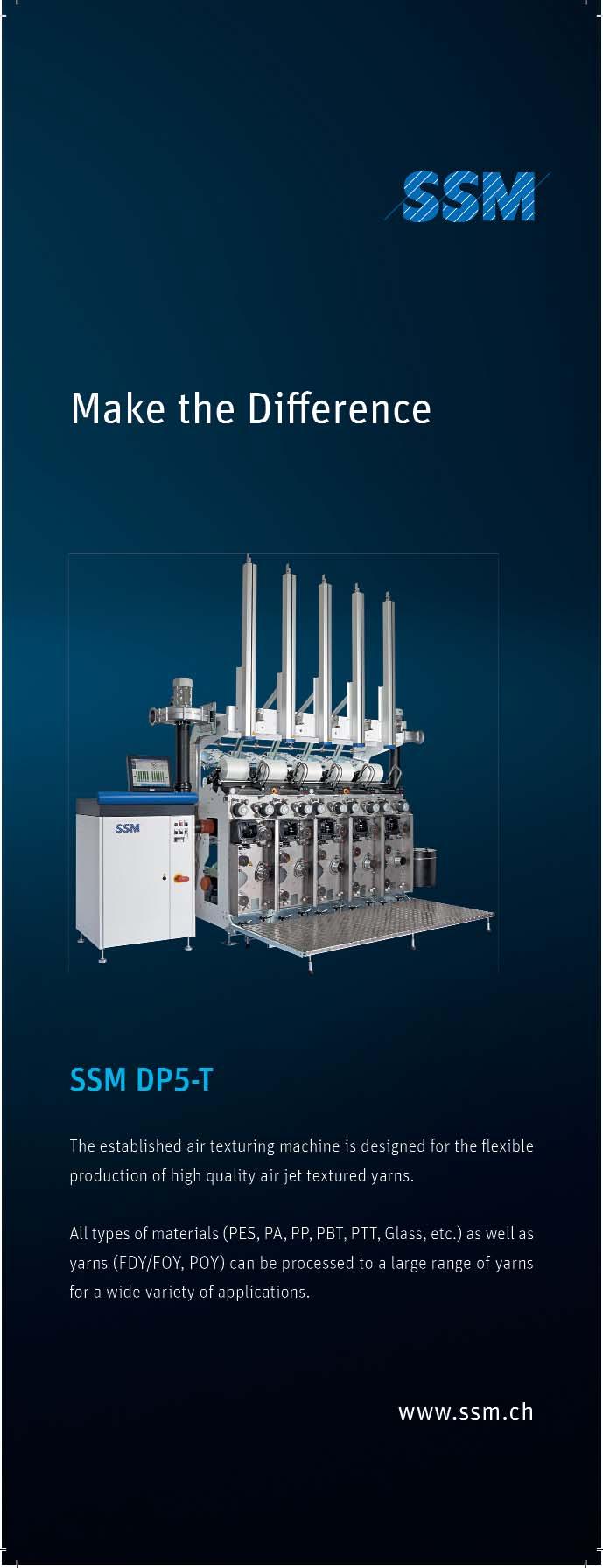
and fabrics were $1968.735 million and $812.234 million respectively during the last year, while imports of yarn and fabrics were $52.274 million and $78.735 million in the same period.
Textile stakeholders in India are against the idea of exporting cotton and yarn from the country as it would enable competing countries including Bangladesh to offer tough competition to Indian exporters after getting cheaper raw materials. It shows that the Indian textile industry needs to develop its strength and formulate an effective strategy when CEPA comes into effect. However, some experts feel that both countries can identify their strengths and be supplementary rather than competing with each other.
ITALY
Italian fashion industry expects record results in 2022
“In 2022, we are going to reach and even exceed the level of sales generated before the 2008 crisis, recording the [Italian] fashion industry’s highest revenue in the last 20 years,” said Carlo Capasa, president of the Italian Fashion Chamber, speaking at the presentation of the forthcoming Milan Fashion Week Women. Of course, Capasa could not avoid underlining the critical issues currently affecting the sector, above all the rise in energy costs which is severely penalizing Italy’s supply chain, manufacturers especially. Still, the outlook for the final part of 2022 remains optimistic.
The 2022 revenue of the Italian fashion and luxury industry as a whole, including textiles, leather goods, apparel, footwear, jewelry, beauty products and eyewear, is expected to reach €92 billion, up 10.5% over 2021. A forecast that is justified by an “extraordinary” performance in H1, which closed with a 25% rise in revenue. “Even if the sector was to stop growing in H2, thanks to the record-breaking first six months of the year we can predict a rise in sales in the region of 10-11% for 2022 as a whole,” said Capasa.
These positive results are partly explained by the price hikes introduced to compensate for the increase in energy
and raw material costs. As noted in the report published by CNMI, “excluding the [consumer] price increase effect, what we might call ‘real’ revenue has grown by over 18% above the level recorded before the 2008 financial crisis.”
Italian companies are currently reaping sizeable benefits from the depreciation of the euro against the US dollar, and their exports have grown significantly towards all countries, with the notable exception of Russia and Hong Kong.

Between January and May 2022, Italian fashion exports increased by 21.9% compared to the same period a year earlier. For 2022 as a whole, the value of exports by the Italian fashion industry is expected to reach Euro 79.4 billion.
In the first five months of 2022, Italian fashion sales have been booming especially in the USA (up by 59.7%), South Korea (up by 34.1%), Spain (up by 31.5%), France (up by 25.1%) and Germany (up by 20.2%). As well as in the UK (up by 22.3%), where sales showed a strong recovery after slumping in Brexit's aftermath.
8,061,925 million yen from Japan during August 2022.
Moreover, Japan exported textile machinery worth 25,223 million yen, which was 13.1 per cent higher than August 2021. It contributed 0.3 per cent to the total exports.
TURKEY
Turkish textile exports end the first 8 months with an increase
The exports of the Turkish textile and raw materials sector increased by 7.5% in the January-August 2022 period compared to the same period of the previous year and reached 8,8 billion dollars, according to the August 2022 Export Performance Report published by ITHIB (Istanbul Textile and Raw Materials Exporters’ Association). The share in Türkiye’s general exports decreased from 5.8% to 5.3% in the same period, while the percentage in August 2022 was announced as 5.0%.

JAPAN
Japan's clothing imports increase 47.3% YoY in August 2022
Japan’s imports of clothing and accessories increased by 47.3 per cent year-on-year to 400,348 million yen (approximately $2,791 million) in August 2022. Clothing imports accounted for 3.7 per cent of the country’s total imports of 10,879,249 million yen during the month under review, as per the provisional trade statistics by Japan’s Ministry of Finance.
The imports of textile yarn and fabrics were valued at 118,233 million yen in August 2022, which is 43.1 per cent higher than the same month of last year. Textile yarn and fabric imports were 1.1 per cent of the total imports of Japan, according to the data.
Japan exported textile yarn and fabrics worth 62,810 million yen, an increase of 19 per cent year-on-year. The textile yarn and fabric exports accounted for 0.8 per cent of the total exports of


Exports of Türkiye’s textile and raw materials sector increased by 1.5% in August 2022 and amounted to 1.1 billion dollars, increasing by 17% compared to July 2022. Türkiye’s general exports increased by 13.1% and reached a value of 21.3 billion dollars, while exports of industrial products decreased by 0.2% and amounted to 11.1 billion dollars in the same period.
USA US Cotton exports take drastic hit in July 2022
Cotton exports from the US witnessed a steep fall to $28.362 million in July 2022 from $1,062.592 million in June 2022. The new cotton marketing season begins in the country from August and exports had reduced drastically in the last month of the previous year 2021-22. However, the country had exported a large volume of cotton during the earlier months.
The country had exported large quantities of cotton till June 2022 due to a scarcity of the natural fibre and skyrocketing prices. Therefore, cotton
Around the World 16 PAKISTAN TEXTILE JOURNAL - October 2022
exports dried up in the last month of the previous season. Cotton exports amounted to $1,162.222 million in May, $1,104.972 million in April, $1,112.802 million in March and $919.778 million in February 2022, according to statistics.
On a quarterly basis, cotton shipment from the US rose to $3.328 billion in the second quarter of this year from $2.820 billion in the first quarter. Exports had declined to $1.002 billion in the fourth quarter of last year from $1.254 billion in the third quarter of 2021. Cotton exports amounted to $1.972 billion in the second quarter of last year.
The world’s largest economy earns $6-7 billion on an annual basis from cotton exports. The country had fetched $5.156 billion in 2021, $6.321 billion in 2020, $6.608 billion in 2019 and $7.088 billion in 2018 from cotton shipments.
VIETNAM

Garment, textile, footwear industries face declining trend in orders
Enterprises in the textile, garment and footwear industries are facing a decrease
in orders through the rest of this year and possibly into the next year.
Pham Xuân Hong, chairman of HCM City Textile and Embroidery Association, said in the eight months of 2022, Viet Nam's textile and garment export value reached US$30.1 billion, but this value mainly came from the first months of the year. Since July, textile and garment industry enterprises have been facing many difficulties, including the reduction in export orders.
Many textile and garment enterprises in HCM City are seeing a sharp drop in export orders, mainly in the US and EU, because inflation pressure in these nations is large, forcing consumers to tighten spending. Furthermore, textiles are not essential goods, Hong said.
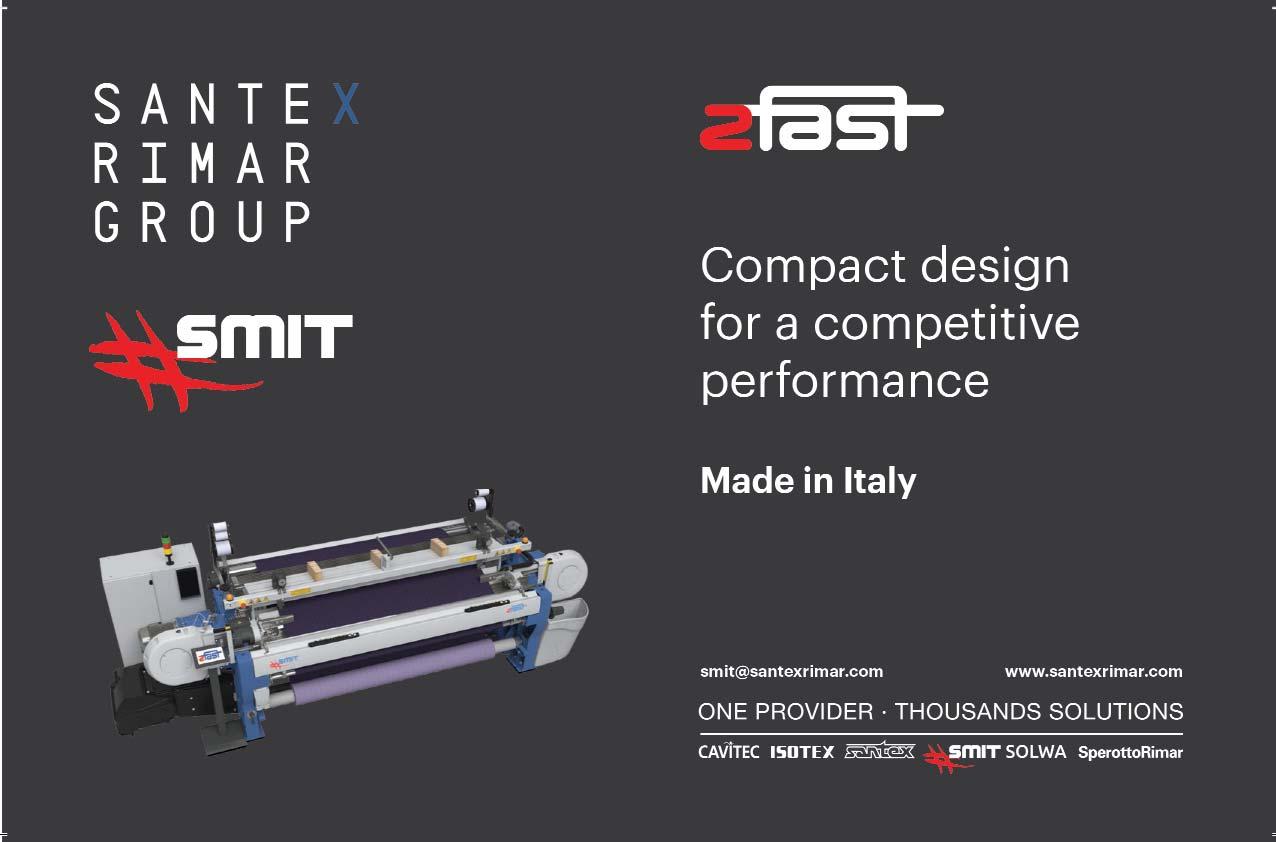
An analysis report on the textile industry published by VNDirect Research has also commented that the demand for high-end clothing items such as shirts and t-shirts made from recycled cotton fibres would slow down in the second half of 2022.
According to this report, garment companies said that US customers had shortened the period of ordering exports
to three months before the deadline for goods delivery instead of six months due to high inventories and inflationary pressures.
At present, only a few large enterprises, such as Thanh Cong (TCM), Century Yarn (STK), and Damsan Joint Stock Company (ADS), have enough export orders for the third quarter of 2022. Still, some customers have cancelled the orders due to high inventory, while fourth-quarter orders have also slowed due to inflation concerns.
In the EU market, Pham Van Viet, chairman of Viet Thang Jean Co, Ltd, has also admitted that the orders of his firm have decreased by over 30 per cent and they have been forced to cut working hours to maintain jobs.
In the US and Europe, although the world fuel prices have decreased, inflation in these markets is still high to make people tighten their spending. This has negatively impacted the textile and garment exports of Vietnamese enterprises because the two markets account for a large proportion of Việt Nam's textile, garment and footwear exports.
Around the World
Hong Kong Polytechnic University announces the establishment of the
school of Fashion and Textiles
On the 25th anniversary of the establishment of the Hong Kong Special Administrative Region, The Hong Kong Polytechnic University (PolyU) announced the official upgrade of the Institute of Textiles and Clothing (ITC) and the establishment of the School of Fashion and Textiles (SFT), the third flagship and independent school within PolyU. The opening ceremony was held at the University's Jockey Club Innovation Tower on 2nd September 2022.
The School is an international institution integrating fashion and textile education, and innovative technology research. It will comprehensively enhance the competitive advantage of SFT graduates and Hong Kong's fashion and textile industry while also aligning it with the market development of the Greater Bay Area. The School's vision is to lead the fashion industry and create societal impact while offering solutions that leverage the research and innovative excellence of the School.
The School is renowned for its worldclass teaching and academic achievements. Its academics come from around the world, specialising and leading the way in a variety of academic and research areas including wearable and smart textiles, medical textiles and functional clothing, social fashion design, sustainable fashion, digital fashion marketing, and fashion supply chain management.
According to a report by Stanford University in 2021, 13 ITC Scholars are ranked among the world's top 2% scientists. Furthermore, according to CEOWORLD magazine, SFT was ranked the second in Asia and 43rd in the world of the World's Best Fashion Schools in 2022.
The School has reached significant milestones in its pursuit of research excellence for societal impact. Last year, SFT was appraised in the Hong Kong University Grants Committee (UGC) "2020 Research Review Exercise", and its research in the creative arts, performing arts and design was the best among the eight UGC-funded institutions.
School of Fashion and Textiles
Formerly known as the Institute of Textiles and Clothing (ITC), the School of Fashion and Textiles (SFT) is the pioneer of fashion and textiles education in Hong Kong. Since its inception in 1957, SFT has developed into a world-class institution in fashion and textile education, research and services. SFT offers a wide range of academic programmes embracing such disciplines as fashion and textiles technology, design, retail and marketing, intimate apparel and activewear, and knitwear design and technology. Its extensive ground-breaking research and innovations have advanced the development of the global textiles and fashion industry and helped transform Hong Kong from a manufacturing and merchandising base in the 1950s and 60s to an international fashion design, creative and branding hub today.

Corporate News 18 PAKISTAN TEXTILE JOURNAL - October 2022

James Heal celebrates its 150th anniversary
James Heal is celebrating its 150th anniversary this year, the company’s formation dating back to 1872, when it was listed as an oil and tallow merchant and mill furnisher in Yorkshire, UK.
“Remarkably, this was seven years before Thomas Edison’s successful invention of the lightbulb, which itself can be considered something of a textile innovation,” says Neil Pryke, UK MD of James Heal’s parent company since 2014, PPT Group. “Its world-changing introduction centred around an uncoated cotton thread that when carbonized to become the filament, could last 14.5 hours.”
Needless to say, on its journey to becoming the leading testing equipment manufacturer for textiles and nonwovens it is today, there have been many internal lightbulb moments within the James Heal organisation over the years – as early as 1899 there are records of the delivery of the first twist tester by the company to a local mill.
Fast forward to 2022 and James Heal continues to expand its range, with a focus on making testing simple, fast and intuitive – most notably with the introduction of its Performance Testing collection of instruments, most recently the AirPro and HydroView systems.

AirPro

The new James Heal AirPro air permeability tester is used to test the resistance of the flow of air through woven, knitted and nonwoven textiles. Its software offers flexibility with standards and comprehensive reporting options and different test head sizes are available, making it suitable for a range of applications and standards
“The way clothing interacts with the body, particularly in respect of the dissipation of heat and moisture, plays a major role in the wearer’s perceived comfort,” says James Heal technical specialist Peter Goodwin. “Today, textile fabrics used for clothing have new functional properties to improve the wearer’s sensory and thermal comfort, meaning that air and water vapour permeability is crucial to achieving clothing comfort – particularly for performance apparel such as sportswear and outdoor clothing.
HydroView
The HydroView hydrostatic head tester is meanwhile designed to measure the penetration of water in materials which have an end use that requires water resistance, such as those in the medical, geotextiles and nonwovens sectors. It is also proving essential in the testing of end-use applications for technical textiles, such as in protective gloves, diving dry suits and winter sports apparel, to fishing waders, roofing, tenting, ground sheets and more.
“As more and more brands are investing in new materials and making performance claims on water resistance and waterproofing, the hydrostatic head test is one of the most common ways to test,” says James Heal’s technical specialist Lisa Keeling. “An example of where hydrostatic pressure might be important, is in testing the groundsheet of a
tent, for example. This needs a high resistance to water penetration, especially when placed on saturated ground. When pressure is applied to the ground sheet by people standing, sitting or sleeping on it, water could then be forced through. Failure in this area would mean anything in contact with the groundsheet will become wet.”
This is also the case with a performance garment claiming waterproof properties, she adds.
“You need a high hydrostatic head value to demonstrate its defence ability against driving wind, rain and other physical factors. Water pemetration testing is key to understanding the performance of a garment in adverse weather conditions.
“HydroView was developed following extensive user research from which James Heal’s innovation team discovered that users were looking for a more flexible and user friendly instrument than was available on the market. With its manual droplet data-capture, combined with ‘pinch & zoom’ hi-res camera analysis, HydroView was designed for the user.”
“James Heal’s testing instruments are trusted and valued by thousands of manufacturers of textiles and nonwovens around the world,” adds Jason Kent, CEO of the British Textile Machinery Association. “The company has made a solid contribution over many decades to the quality and performance properties of today’s textile products, and just as importantly, enabled its customers to prove their claims.”
Corporate News 20 PAKISTAN TEXTILE JOURNAL - October 2022
The James Heal AirPro air permeability tester.

Rieter expands service footprint in Kahramanmaraş, Turkey
Rieter is moving its Kahramanmara service station to a larger location covering 2 000 m2 in a bid to broaden its offering and strengthen its market position in Turkey. The station will house one of the region’s largest testspinning facilities and provide know-how in sustainable yarn manufacturing.
The comprehensive portfolio covers both mechanical and electronic services, including the revision of gear units, servomotor adjustments, and suction drums. The station will also offer preventive maintenance and mill optimization. The service offering spans the entire Rieter product portfolio, including the automatic winding machine Autoconer X6. In addition, highly trained experts will help customers unlock the full potential of Rieter technology so they can better capture opportunities in the fastmoving textile markets.
Highlights of the Kahramanmara Service Station include the setup of a fully automatic rotor spinning machine R 70 and the winding machine Autoconer X6. Threequarters of the 2 000 m2 service space is reserved for functional activities,
which will feature one of the region’s largest test-spinning facilities. Customers can run yarn comparison tests and analyze the impact of different technology parts so they can optimize machine setups. In-depth yarn trials and access to Rieter textile technology expertise will allow customers to cater more effectively to the dynamic demands of textile brands regarding performance, quality and sustainability, such as recycling applications.
The Kahramanmara service station is strategically located at the heart of the region’s textile industry, with a large proportion of Rieter’s installed base located within a radius of around 200 kilometers. Turkey is a textile powerhouse, currently ranking fifth in
global exports and poised for additional growth. The country’s industry is also implementing a green action plan to help it meet the growing demand for sustainable textiles, especially from Europe.
Rico Randegger, Head of Business Group After Sales, says: “Customer centricity is a priority for us and the opening of the Kahramanmaraş service station is an important milestone. We are moving closer to our customers so we can help them seize growth opportunities faster and more effectively.”

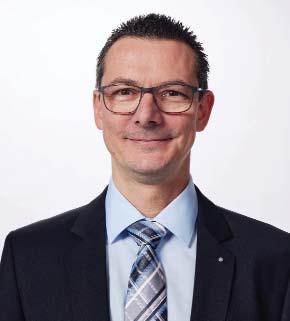
Ali Özsamsun, Managing Director Rieter in Turkey, says: “The sole measure of success is the competitiveness of our customers. We support customers throughout the lifetime of their products and systems so they can unlock the full potential of Rieter technology and win in the market.”
The new service station starts operations in September 2022 and will accelerate the growth of the company’s three stations in Turkey. Rieter has been operating service stations in Turkey since 2005 with a presence in the country dating back to the 1990s.
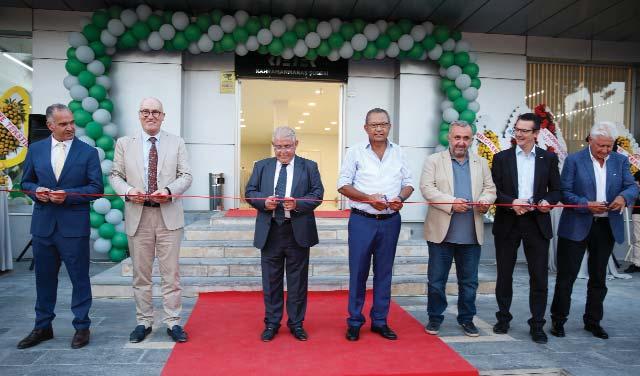

Corporate News 22 PAKISTAN TEXTILE JOURNAL - October 2022
Rico Randegger, Head of Business Group After Sales
Ali Özsamsun, Managing Director Rieter in Turkey
The new 2 000 m2 Kahramanmaraş service station includes one of the region’s largest testing facilities and gives access to Rieter textile expertise.
Ribbon Cutting Ceremony (from left to right): Ali Özsamsun, Managing Director Rieter in Turkey, Erkan Ateşler, Member of the Board of Erbel Mümessillik, Hanefi Mahfiçiçek, City Mayor, Hanefi Öksüz, Chairman of Kipas Holding, Arif Sirikci, Chairman of Sirikcioglu, Rico Randegger, Head of Business Group After Sales, Haluk Erbel, Board Chairman of Erbel Mümessillik

ExxonMobil expands product portfolio to advance healthcare solutions
ExxonMobil has expanded its portfolio of healthcare solutions to meet changing medical market needs for healthy, safe material options.
Adhering to industry requirements for testing, quality assurance and traceability, the portfolio unites a wide range of highperformance products that are produced using Good Manufacturing Practices (GMP) for batch-to-batch product consistency that customers can rely on. Maximizing performance and longevity for a range of medical supplies
Delivering high-purity products for laboratory components and pharmaceutical packaging to meet the toughest standards Innovating to improve cleanliness and safety for better infection protection The portfolio provides the building
blocks to engineer a range of applications including medical supplies, infection protection products, and pharmaceutical and laboratory supplies. The portfolio includes Achieve™ Advanced PP, ExxonMobil™ PP, Vistamaxx™ performance polymers, Exact™ polyolefin elastomers, ExxonMobil™ butyl polymers, Exxpro™ specialty elastomers and ExxonMobil™ Isopropyl Alcohol (IPA).
“The decision to create a portfolio of healthcare solutions, supported by a dedicated team of trusted industry application experts, was cemented by a combination of market factors, including the COVID-19 pandemic,” said Market Development Manager Gertrud Masure. “With a legacy of innovation that spans over 100 years, ExxonMobil is well placed to meet demand from customers for a broader selection of alternative solutions
that promote healthy and safe patient care.”
The COVID-19 pandemic, which required rapid production of face masks and other products to help combat virus transmission, was a major factor in ExxonMobil’s decision to create a portfolio of healthcare solutions.

The healthcare industry’s desire for a polyvinyl chloride (PVC) replacement was another market driver which led ExxonMobil to develop suitable alternatives. While another motivating factor was customers’ preference to do business with a single-source materials supplier.
ExxonMobil’s high-quality, compliantsafe material solutions enable tailored innovation for:
Optimized performance and longevity of medical supplies, includ-
Corporate News 24 PAKISTAN TEXTILE JOURNAL - October 2022
ing drug/medical fluid delivery. Applications include syringes, infusion bags, IV/saline containers, ostomy bags, inhaling systems, drug and vitamin tubes, bottles, vials, containers, caps, seals, closures, briefs, and absorbent pads.
Purity required to meet the toughest standards for laboratory components and pharmaceutical packaging solutions, including labware, sanitizers, bio reactor bags, and pharmaceutical stoppers/seals.

Cleanliness and safety for protective products, such as face masks, gowns, gloves and alcohol wipes that help prevent infection.
Softness, loft, strength, improved barrier performance and ease of processing for spunbond or meltblown nonwoven products. Typical applications include absorbent articles, medical PPE, bandages, masks, gowns and wipes, surgical drapes and gowns, medical protective gowns, shoe covers, disposable bedding and
hospital apparel, pads, wraps, and filtration media.
“It really is the sum of the parts that makes our healthcare portfolio so attractive to customers,” said Americas Market Development Manager Abigail Agentis. “We seek to meet industry needs with a trusted portfolio of performance products that adhere to strict industry requirements for testing, quality assurance and traceability. Our collective motivation is to deliver innovative healthcare and pharmaceutical products that help enable patients to receive best-in-class, safe treatment.”
To support its commitment to the healthcare industry, ExxonMobil is dedicated to fulfilling the future business needs of its customers by continuing to invest in production capacity and comprehensive supply chains. For example, ExxonMobil’s Polypropylene Growth Project in Baton Rouge is nearing completion, and the company continues to make good progress in support of a 2023 startup of the $2 billion investment
to expand its Baytown chemical plant with a new Vistamaxx unit and worldscale, full range Linear Alpha Olefins unit. Products from both are expected to be used for a broad range of applications.
ExxonMobil has expanded its portfolio of healthcare solutions to meet changing medical market needs for healthy, safe material options.
About ExxonMobil
ExxonMobil, one of the largest publicly traded international energy companies, uses technology and innovation to help meet the world’s growing energy needs. ExxonMobil holds an industry-leading inventory of resources, is one of the largest refiners and marketers of petroleum products, and its chemical company is one of the largest in the world. To learn more, visit exxonmobil.com and the Energy Factor.
* Recyclable in communities with programs and facilities in place that collect and recycle plastic film
Corporate News
25
DYSIN GROUP inaugurates its new plant for Specialty Polymer manufacturing in Gazipur
Dysin Group, one of the pioneers to introduce new technologies for the knitdyeing, garments washing, and garments printing industries in Bangladesh since 1984, has set up a new plant for Specialty Polymer Manufacturing under the name of Dysin-Chem Industries (Pvt.) Ltd. at BCSIC Industrial Area, Konabari, Gazipur. The new plant was inaugurated on 16th of September, 2022.
“We have been working in the textile industry since 1984, providing Dyestuff and Chemicals with technical services. Now Dysin is recognized as a trusted leader in delivering innovative and sustainable chemical solutions across multiple industries. The setup of a specialty Polymer Manufacturing Plant is an important part of our vision to grow in local manufacturing capability. This plant will serve to produce the intermediate chemicals used as raw materials in our textile auxiliaries manufacturing, in turn reducing the cost.” Managing Director of DYSIN Group, Mr. Md. Amanur Rahman
said. He also added, “Our first manufacturing unit for Textile Auxiliaries was established in 1990. Now Dysin has three chemical manufacturing units under two companies, including a 100% export-oriented unit that serves the Export factories having a bond license.”
Mr. Rahman pointed out that instead of importing chemicals from abroad, textile mills can save valuable foreign currency, reduce their inventory, and reduce the lead time of garments export if they buy from local Textile Auxiliaries manufacturing companies like those of the DYSIN group.
Recently, Dysin Group’s Textile Auxiliaries manufacturing unit under the name of NAM Trading & Manufacturing Co., Ltd., became the first company in Bangladesh to receive ZDHC Confidence Level 3 certification (Zero Discharge of Hazardous Chemicals) – the highest ZDHC certification level currently available. In this regard, Mr. Rahman said, “Working to be certified as ZDHC level 3 was a key achievement in our
commitment to drive the Bangladesh textile industry to be more environmentally friendly and reduce its impact on the environment”.
Mr. Rahman, who is also the convener of Bangladesh Chemical & Dyestuff Manufacturers’ & Exporters’ Association, said, “We believe Bangladesh is at a turning point of Industrialization with huge potentials for growth in Chemical Industry, which can bring the second wave of industrial and export growth after the textile industry. However, we need Government’s policy support for this sector very much.”
Dysin is continuously investing to expand its R&D and manufacturing capabilities of Chemicals for Textile & other industries. We want to provide maximum benefit through “specialized” high-performance chemicals, for our customers to win in the marketplace, save our environment and contribute to making the world a better place, the company said in a media statement.

26 Corporate News 26 PAKISTAN TEXTILE JOURNAL - October 2022
Trützschler Group SE expands Board of Directors
The Trützschler Group SE has appointed Dr. Ulrich Schwenken and Heinrich Krull to its Board of Directors with effect from July 1, 2022. Dr. Schwenken will serve as Chief Executive Officer (CEO). Heinrich Krull will serve as Chief Operations Officer (COO).
Dr. Schwenken will assume responsibility for Development, Digitalization, IT and Corporate Communications. As a doctoral graduate specialized in engineering, he has many years of experience in automotive and mechanical applications. Since 2008, he has held various management positions in the areas of Service, Sales and Development at companies including Porsche AG and Volkswagen AG, where his responsibility covered a range of key topics such as digital transformation. Most recently, Dr. Schwenken served as CSO, CTO and CDO at Leistritz AG, and
was responsible for the strategic focus on innovative growth areas.
Mr. Krull joined Trützschler Group SE in September 2020. As a graduate engineer for production engineering and management with international experience in mechanical and production site engineering, he has comprehensive expertise related to operations. He also has extensive experience of production technologies, including in-depth knowledge of Lean Management methods and expertise in post-merger integration. As COO, he will be responsible for the areas of Production, Purchasing and Logistics, Quality Assurance as well as Supply Chain.

“We are delighted to welcome Dr. Schwenken and Mr. Krull to the Board of Directors. Both will bring diverse expertise to strengthen the development of the company for future growth. We wish them great success in their new tasks,”
says Dr. Roland Münch, Chairman of the Supervisory Board of Trützschler Group SE.
Until his scheduled retirement at the end of 2022, Dr. Dirk Burger will act as Co-CEO to Dr. Schwenken.
The responsibilities of the Board of Directors of Trützschler Group SE as of July 1, 2022 are as follows: Dr. Ulrich Schwenken (CEO) is responsible for Development, Digitalization, IT and Corporate Communications; Dr. Dirk Burger will take over the role of Co-CEO to Dr. Schwenken until the end of 2022; Dr. Ralf Napiwotzki (CFO) is responsible for Finance and Controlling, Human Resources, Legal and Compliance; Alexander Stampfer (CSO) is responsible for Sales, Marketing and Service; Heinrich Krull (COO) is responsible for Production, Purchasing and Logistics, Quality Assurance as well as Supply Chain.

27 Personalia
The new members of the Board of Directors of Trützschler Group SE: Dr. Ulrich Schwenken, CEO Trützschler Group SE (left); Heinrich Krull, COO Trützschler Group SE (right).
ITMA ASIA + CITME 2022
rescheduled to November 2023
ITMA ASIA + CITME 2022 has been rescheduled to November 2023 due to the uncertain pandemic situation in China.
Show owners CEMATEX and Chinese partners, the Sub-Council of the Textile Industry, CCPIT (CCPIT-Tex), China Textile Machinery Association (CTMA) and China Exhibition Centre Group Corporation (CIEC) advised that the new show dates will be announced shortly.

Mr Ernesto Maurer, President of CEMATEX, stated: “Due to the present circumstances in China, we have decided to reschedule the combined show to next year when the pandemic situation is expected to stabilise. As the exhibition features the participation of overseas exhibitors and visitors, we believe it is in the interest of the industry that we postpone the exhibition to allow greater participation at the most important textile machinery exhibition in Asia.“

Mr Gu Ping, President of China Textile Machinery Association (CTMA), said: “We are very grateful to our exhibitors, media and industry partners for their support. Although the preparatory work has been going smoothly and we are looking forward to the exhibition opening, we must also ensure the health and safety of all our participants.”

ITMA ASIA + CITME 2022 is organised by Beijing Textile Machinery International Exhibition Co., Ltd and coorganised by ITMA Services. Japan Textile Machinery Association is a special partner of the show.
Originally scheduled to take place from 20 to 24 November 2022, the 2023 exhibition will continue to be held at the National Exhibition and Convention Centre (NECC).
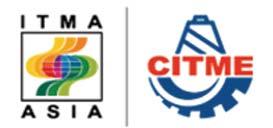
28 PAKISTAN TEXTILE JOURNAL - October 2022
Mr Ernesto Maurer, President of CEMATEX.
Fairs and Exhibitions
Mr Gu Ping, President of CTMA.
India ITME 2022 at new world class Venue – IEML, Greater Noida
The 11th edition of India ITME will be held from 8th – 13th December 2022 at India Exposition Mart Ltd (IEML), Greater Noida.

This event is being held in welldesigned Exhibition Venue in the National Capital Region and one of the largest in India, with lovely weather in December. It is an opportunity to combine business with travel, experience and also explore Delhi and capital region of India.
The only event in India which brings together 73 countries and 97 domestic regions Pan India under one roof; of this 52% of visitor’s belong to top management and decision makers enabling to close business deals decisively. India ITME-2022 is going to be very exciting business event for Textile and Textile Engineering Industry after a long gap.
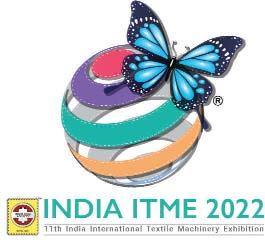
India being home to the world’s second largest textile industry, India is also a very important sourcing hub for textile machinery, Technology, Components and Allied Services.
There are 22 chapters as listed below from fibre to finished products providing complete sourcing solutions, competitive pricing and latest technology:
Spinning machines and spare parts. Weaving.
Processing.
Digital Printing. Garments.
Knitting & Hosiery. Embroidery & Braiding. Non-woven & technical textiles. Dyestuffs and chemical products. Laboratory testing and measuring. Integrated Textile Parks. Fibers and Yarns. Software and Design. Recycling & Waste Management.
Visitors will be pleased with a large range of textile technologies. The price competitive high quality textile machinery in all sectors will be on display at India ITME 2022.
This is the only event in India which brings together 73 Countries & 97 domestic regions Pan India.
India ITME Society jointly with EEPC is organizing Reverser Buyer Seller Meet & B2B meetings concurrent to India ITME 2022.
This Event would be an excellent platform for textile industry business visitor to meet and network for new business opportunity both with Indian industry as well as other countries.
As an event organizer, India ITME Society is a globally trusted name for quality, excellence and has successfully served the industry with commitment. We hope and strive to provide a spectacular event which shall also coincide with the completion of 43 years of the Society.
29 Fairs and Exhibitions
Field tests confirm high performance of new Accotex aprons
The latest Accotex apron NO-79201 is made from new compounds that deliver longer life and better performance. Flexible enough to work with all fiber types across ring and compact-spinning machines, field trials show better resistance throughout a 12-month spinning cycle. The NO-79201 is available in a wide range of dimensions as top and bottom aprons for all kinds of applications.

The Accotex NO-79201 (Fig.1) is a new generation of aprons for ring and compact spinning machines. It is made of two aligned rubber compounds which deliver a high abrasion and crack resistant spinning apron. The mechanical robustness of the rubber compounds allows effective use on all ring and compact-spinning machines, working with all fiber types and within the whole spectrum of yarn counts. The excellent friction properties of the compound contribute to a smooth and even running over the whole service life of the apron, especially at the start-up of machines.
Superior friction behavior
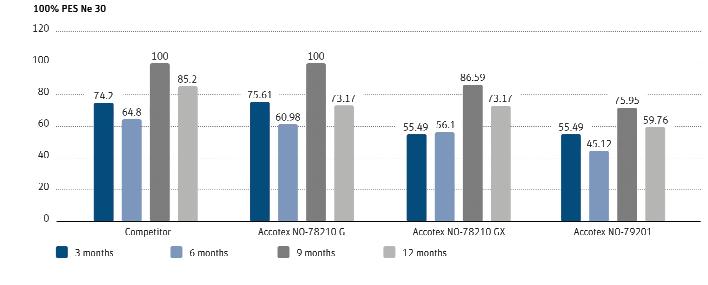
The new Accotex NO-79201 was tested for 12 months at a customer in the USA, alongside the already existing NO78210GX, the NO-78210G and a competitor’s apron (Fig. 2). The friction value of the different aprons was measured over the whole apron life in regular frequencies. Each column reflects the individual friction value of the inner layer evaluated on representative apron
samples from the field test at 3, 6, 9 and 12 months. After 12 months running, the inner layer friction of the new NO-79201 is nearly unchanged, confirming the smooth and even running over the whole service life of the apron. This superior friction behavior has also been reported from other Accotex customers across the world, processing different fiber types, blends and yarn counts. Besides, these trial customers have noticed far fewer broken bottom aprons than they would normally expect.
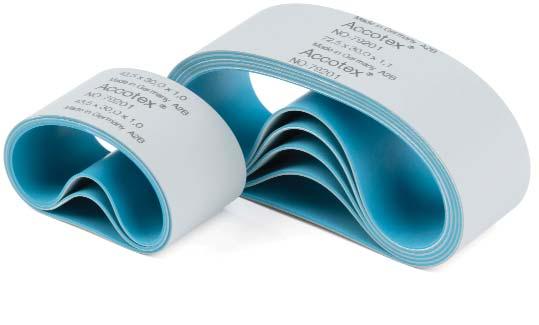
Different versions for flexible use
The Accotex apron NO-79201 is available in a wide range of dimensions as top and bottom aprons for all kinds of applications. It comes as closed apron, skived bottom apron or skived and preglued bottom apron. The NO-79201 can be supplied with a plain inside or a
specially configured inner layer pattern, known as a knurled version (Fig 3).
The main benefit of the knurled apron is to provide less contact area to the nose bar, which enables lower torque, and thus less stress on the bottom roller bearings. This also allows the inside structured apron to run clean on so-called “dirty” fibers and to work efficiently in demanding environmental conditions in terms of fiber cleanliness. The knurled apron is available with diameters of 72.5, 76.3 and 79.0 mm.
Overall, the new Accotex NO-79201 spinning apron provides improved performance for ring and compactspinning with less machine downtime. Its flexible application may also reduce stocking levels and simplify servicing regimes.
Features 30 PAKISTAN TEXTILE JOURNAL - October 2022
Fig.1: Accotex NO-79201 is available in a wide range of dimensions as top and bottom apron for all kinds of applications.
Fig. 3: Accotex NO-79201 can also be supplied with a knurled inner layer, for increased service life.
Fig. 2: The new apron NO-79201 shows nearly unchanged inner layer friction, confirming unmatched performance over time.
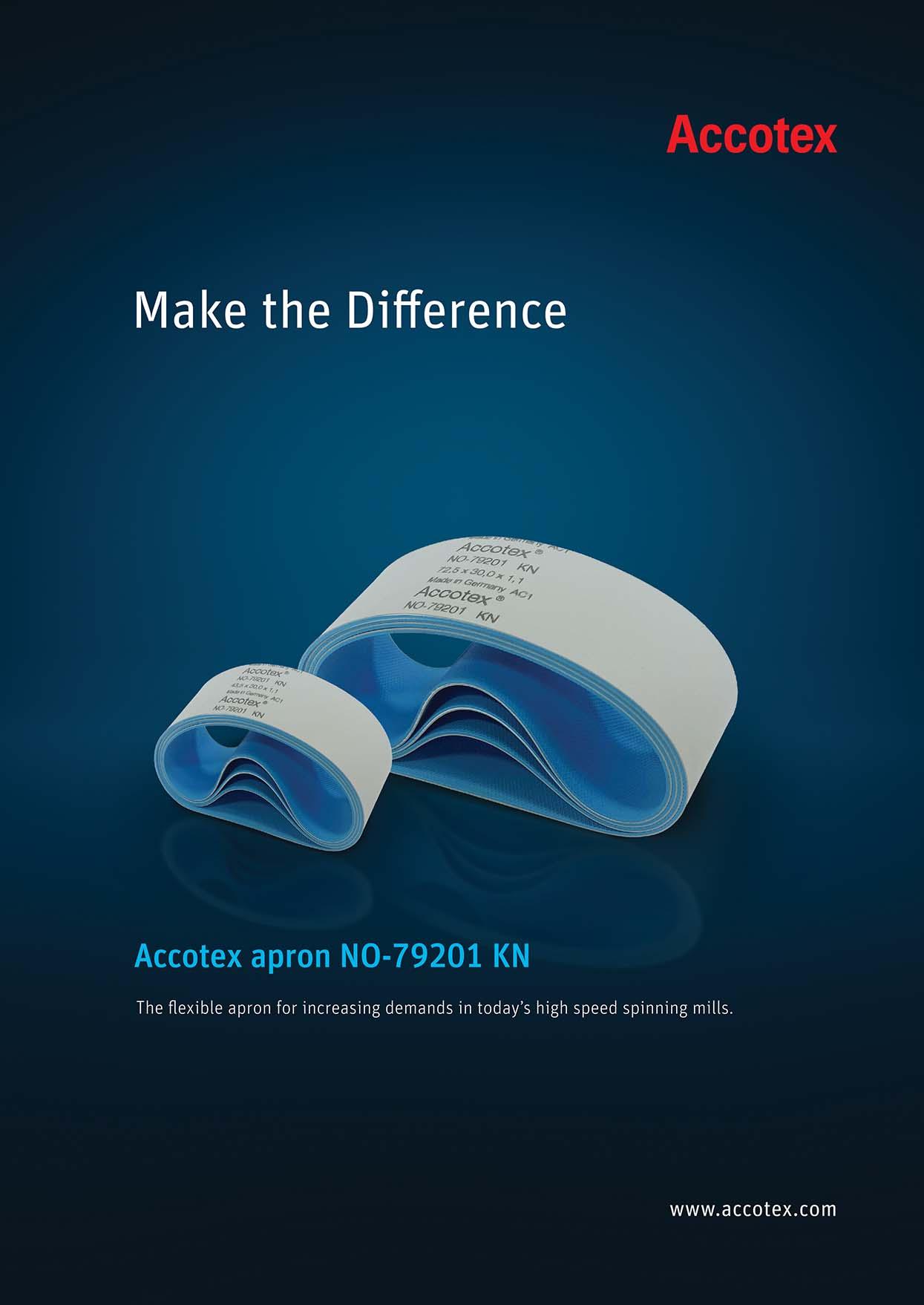
The LYCRA Company Announces Collaboration with Qore® to use QIRA® for next Generation BioDerived LYCRA® Fiber at Scale
The LYCRA Company, a global leader in developing innovative fiber and technology solutions for the textile and apparel industry, today announced it has entered into an agreement with Qore® to enable the world’s first large-scale commercial production of bio-derived spandex using QIRA®, the next generation 1,4-butanediol (BDO), as one of its main ingredients. This will result in 70% of the LYCRA® fiber content being derived from annually renewable feedstock. This change could potentially reduce the carbon footprint of LYCRA® fiber by up to 44%* versus equivalent product made from fossil-based resources, while maintaining the same high-quality performance parameters of traditional LYCRA® fiber.
QIRA® will be produced at Cargill’s biotechnology campus and corn refining operation in Eddyville, Iowa. The facility, which is currently being built, will commence operations in 2024. The first renewable LYCRA® fiber made with QIRA® will be produced at The LYCRA Company’s Tuas, Singapore
manufacturing site in 2024. The LYCRA Company is currently seeking commitments with brand and retail customers who are pursuing bio-derived solutions for their apparel.
“As part of our sustainability goals, we are committed to delivering products that support a more circular economy while helping our apparel and personal care customers reduce their footprint,” said Julien Born, CEO of The LYCRA Company. “We are especially pleased to collaborate with Qore®, a company that shares our vision for innovative, sustainable solutions. Their expertise in operating fermentation processes and understanding of the chemical value chains makes them the ideal partner to help develop a bio-derived LYCRA® fiber at commercial scale.”
“We are proud to partner with The LYCRA Company on bringing this sustainable material solution to the market. This collaboration demonstrates that QIRA® directly replaces conventional BDO and thus significantly improves the fiber’s sustainability profile,” said Jon

Veldhouse, CEO of Qore®. “QIRA® is an innovative platform chemical that can be used in various applications across industries.”
The first generation of renewable LYCRA® fiber made with QIRA® will use feedstock from field corn grown by Iowa farmers and will enable a significant reduction in CO2 footprint. In addition to replacing a finite resource with an annually renewable one, another benefit for mills, brands and retailers is that there is no change in fiber performance, eliminating the need for any reengineering of fabrics, patterns, or processes. Equivalent performance was demonstrated in 2014 when the world’s first bio-derived spandex was launched under the LYCRA® brand. The LYCRA Company has since been granted a patent for the process used to make renewable elastane from bio-derived BDO.
LYCRA® is a trademark of The LYCRA Company.
Qore® and QIRA® are trademarks of Qore® LLC.
32 PAKISTAN TEXTILE JOURNAL - October 2022
Features
The LYCRA Company signs an agreement with Qore® LLC to enable large-scale production of bio-derived spandex. Pictured – Julien Born, CEO of The LYCRA Company (left), and Jon Veldhouse, CEO of Qore® LLC (right), at The LYCRA Company’s headquarters in Wilmington, DE, USA.
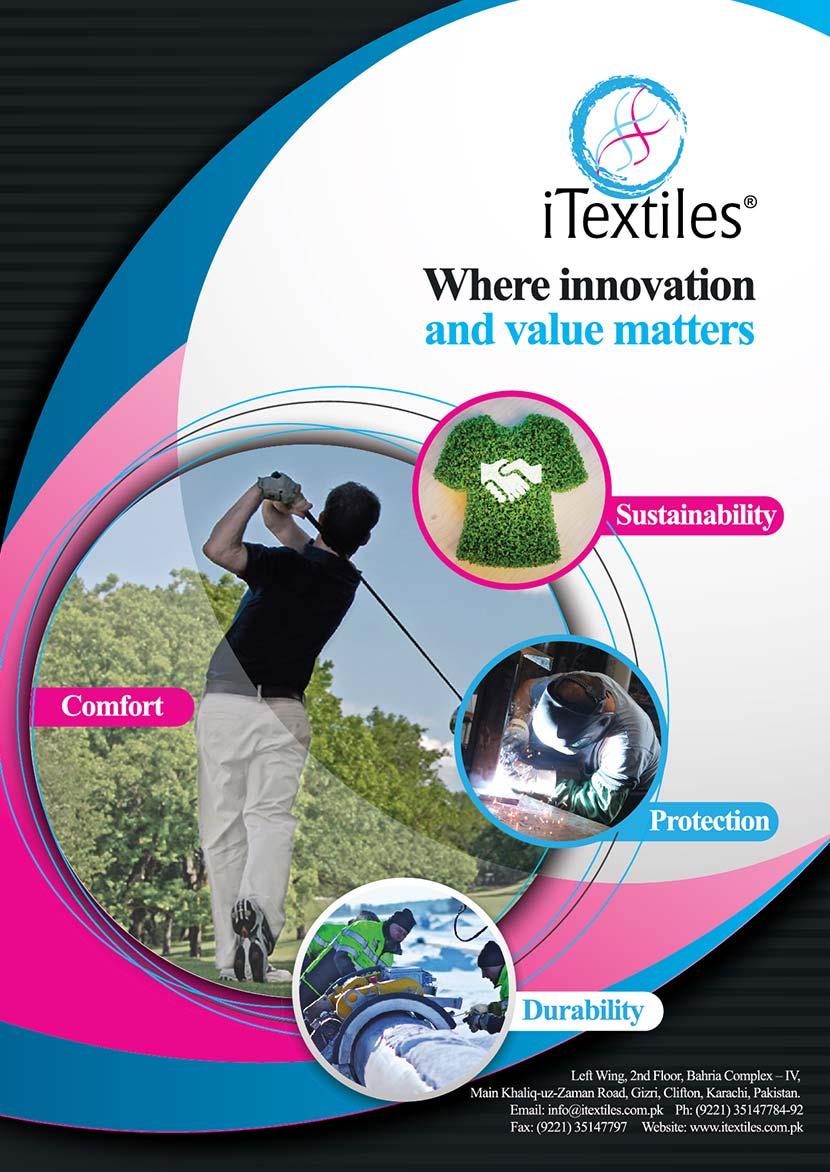
World Cotton Day: Challenges for Pakistan’s cotton industry


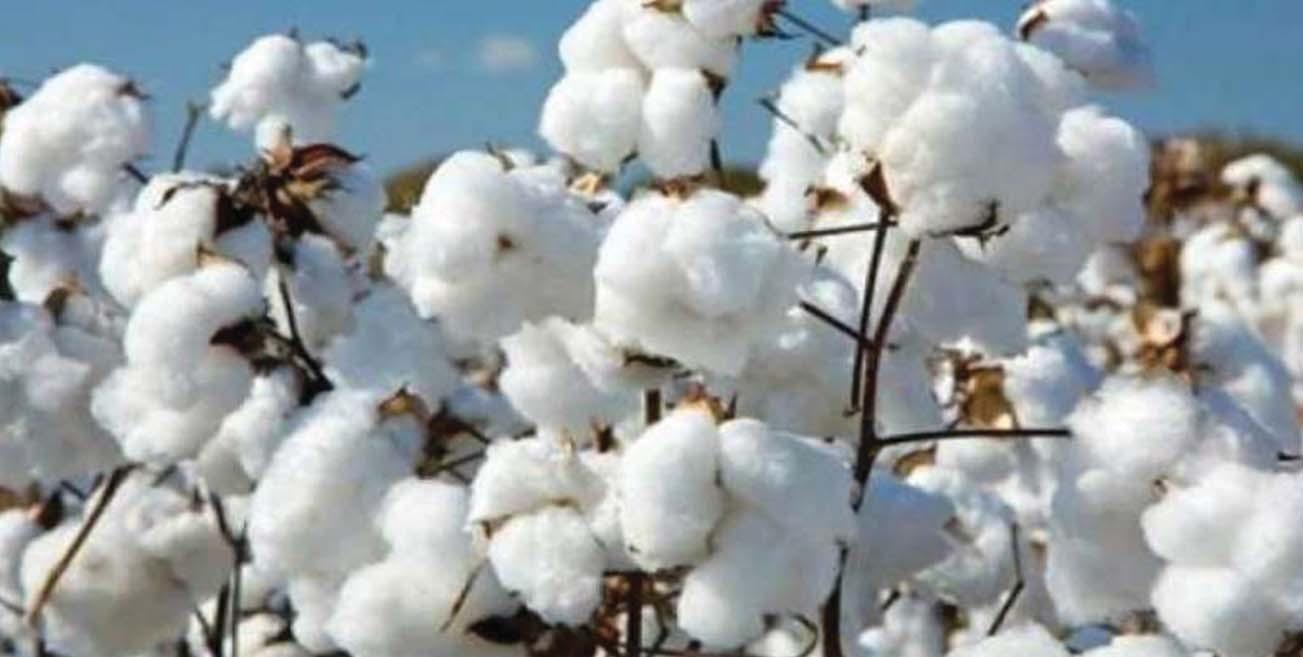 Dr. Muhammad Qasim Siddiqui
Dr. Muhammad Qasim Siddiqui
The World Trade Organization (WTO) in collaboration with United Nations (UN) celebrates the World Cotton Day (WCD). Cotton is the most widespread profitable non-food crop in the world which provides income for more than 250 million people worldwide across 75 countries. Today, the world is using more cotton fiber than any other natural textile fibers specially in apparel and home textiles. Despite the fact of being expensive, cotton remain preferred in many minds due to its natural and comfort properties.
Devastated by recent rains and floods, cotton producing belt in Sindh and southern Punjab, the production is forecast down 700,000 bales to 5.5 million bales (1 bale = 218 kg), the second lowest production level in nearly 40 years. World cotton production is forecast at 118 million bales for 2022/23 (USDA cotton outlook September 2022). Globally, cotton has been grown on around 33 million hectares, with an average yield of 793 Kilograms/hectare.
In year 2021, with the production of 7 million bales (218 kg/ bale), Pakistan has inherent advantage of being 5th largest producer of cotton fiber after India, China, USA and Brazil. China is the largest cotton importers followed by Vietnam and Bangladesh. Pakistan spinning mill consumes/ demands more than 10 million bales. The yield of cotton in Pakistan is around 600 kg/hectare, while China and Brazil produce per hectare yield above 1500kg. This difference in yield underpins fatal negligence as a nation.
Every single part of cotton plant has its own value; clean cotton fiber lint is the most important segment used to produce home textiles and apparels. Linter, the short fuzz on cotton seed is source of pure cellulose for many products, like plastics and papers. Finally, the remaining cotton seed has to be crushed and separated into three items, that are oil, meal and hulls. These sub products are used as livestock feed, that makes cotton crop overall a cash crop.
In Pakistan,1.3 million farmers cultivate cotton on around 2 million hectares, 17 % decreased over last year, covering 15 per cent of the cultivable area in the country (Economic survey of Pakistan 2020-21). More than 10 million peoples are employed in cotton production and processing industries. Cotton and cotton products contribute about 10 per cent to GDP and 55 per cent to the foreign exchange earnings of the country. Taken as a whole, between 30 and 40 per cent of the cotton ends up as domestic consumption of final products. The remaining is exported as raw cotton, yarn, cloth, home textiles and garments. As per economic survey of Pakistan 2020-21, total exports of cotton and cotton made textile products were at record more than 15 billion USD.
The country’s last bumper cotton crop of 14.9 million bales were harvested in 2013-14. The Cotton Crop Assessment Committee (CCAC) has revised cotton production estimates to 8.46 million bales of 170 kg each for this season (2021-2022). Decrease in production of cotton crop also caused decline in cotton ginning by 12.7 percent. International Cotton Advisory committee USA in its study showed that production cost of cotton in Pakistan is higher than India and Argentina.
In Pakistan, the cotton farms (half are smaller than 2 hectares) competing in almost classic competition, a vast majority operated as family farms by owners/ cultivators with limited literacy or access to technology. With the rise of new concerns, especially those pertaining to environmental and social conditions the competition is getting furious. Cotton plants are susceptible to a large variety of pests and diseases that can cause stunted growth, poor color, lower yields, or even death. Pesticide use in cotton alone is valued at US$ 2 to 3 billion annually, which is one quarter of the total insecticide consumption in the world. It has become a significant proportion of production costs.
Water use and common tilling practices effect water quality adversely, and lead to water scarcity, soil erosion, and waterlogging and salinity. Chemical fertilizers cause soil and water contamination, and affect soil fertility. Some chemical dyes and chlorinates used in the processing stage have carcinogenic effects; others have adverse consequences for human health and water quality if discharged without proper treatment.
Better cotton crop can be achieved from improving per hectare yield, reducing the risk of cotton curl virus and introducing long staple length verities. To achieve better crop output, we have to focus on optimized farming system, transformative technology along with protection from biotic threats and environmental stresses. The advent of new production technologies and better management practices has given rise to an almost 100% in-crease in average global yields over 30 years, up from 411 kg/ha in 1980/81 to790 kg/ha of cotton lint.
In fact, the significance of the cotton sector far exceeds its contribution to GDP or exports. The rate of economic growth is dependent quite closely on the fate of the cotton crop. Cotton fiber has been fed as local raw material for the textile industry of Pakistan which is the largest contributor in the country’s exports. The textile supply chain consists of ten industrial subsectors starting from cotton picking to finish garment, all of these are directly related with the quantity and quality of indigenous cotton crop. This immense advantage needs to be converted into a sustainable competitive growth coupled with the socio-economic uplift of Pakistan.
Author is an international expert in Cotton Quality from ICA Bremen GmbH Germany, currently working as, Associate Professor, Department of Textile Engineering, BUITEMS, Quetta.
34 PAKISTAN TEXTILE JOURNAL - October 2022 Features

Economical Compact-Spinning using state-of-the-Art Technology
The COMPACTeasy mechanical compacting system from Suessen addresses the need for higher productivity and cost optimization in compact spinning. The system can spin highquality yarn from all common raw materials – at a high speed. Low investment cost, less energy consumption and minimal maintenance make COMPACTeasy an attractive alternative to pneumatic systems for spinning mills.
Saving energy and cost are decisive factors for spinning mills today. Most spinning systems require both a high level of initial investment as well as considerable operating cost. While


Fig. 1: The y-channel in the compactor enables intense double compacting for all yarn counts.
compact spinning is appreciated for its excellent yarn quality and high productivity, it can also be very costintensive, especially with pneumatic compacting systems requiring a lot of electricity.
Unmatched compact-spinning quality
Continually striving to push boundaries of innovation, Suessen developed COMPACTeasy, a mechanical compacting solution that offers low
36 PAKISTAN TEXTILE JOURNAL - October 2022
Fig. 4: COMPACTeasy can be installed in new and existing ring spinning machines.
investment cost without compromising on quality. It produces yarns with excellent characteristics from a broad range of raw materials, such as cotton and man-made fibers, as well as their blends. With a count range from Ne 20 to Ne 60, COMPACTeasy covers most applications.
The recipe for success
COMPACTeasy guides fibers through the y-channel of the compactor with precision, which results in intensive double compacting (Fig. 1) without any additional energy requirements compared to ring spinning.
Compared to other mechanical systems, the compacting channel of
COMPACTeasy is much wider, so it is less prone to clogging. Thanks to the traverse motion of the compactor (Fig. 3), the lifetime of cots is extended resulting in lower maintenance requirements and constant and durable yarn quality. This is a considerable advantage compared to flipping the front top roller, which is what mechanical systems usually require.
Sophisticated technology for less wear and tear
The device consists of a front toproller retainer and the smaller COMPACTeasy roller (Fig. 2). The compactor features the y-channel and the preceding pin and is located between the two top rollers. The compactor spring uses a low spring force to press the
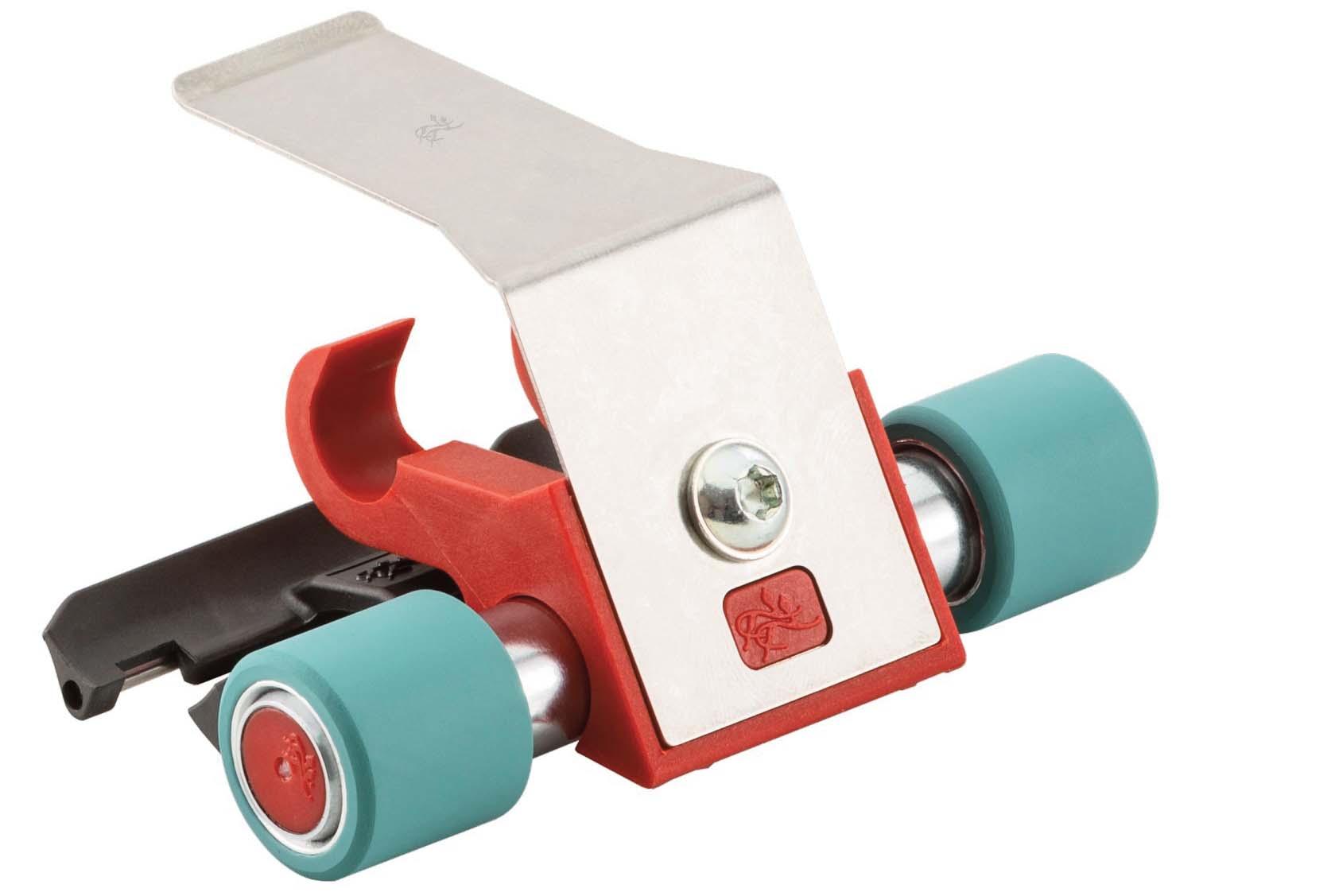
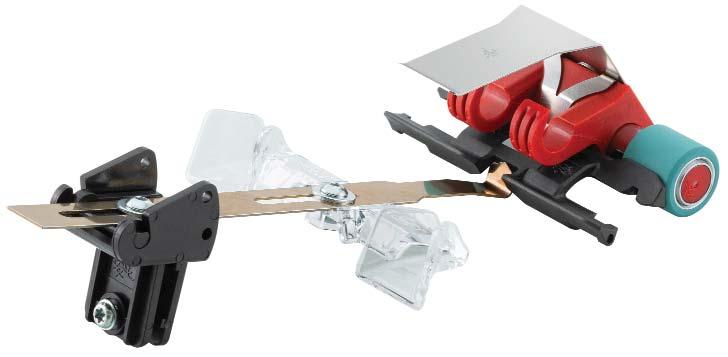
compactor against the bottom roller. This causes considerably less wear and tear on the compactor than magnetically loaded compacting elements.
The yarn quality is determined by both the y-channel of the compactor and the integrated pin, which takes effect precisely in the zone of the drafting system where the fibers have the least guidance. This process improves yarn irregularity and increases yarn tenacity. Hairiness is also significantly reduced and often achieves better results than pneumatic compacting systems.
Flexibility and compatibility
COMPACTeasy can be added to the specifications for new ring spinning machines (Fig. 4). Furthermore, machines that have already been installed can easily be retrofitted. COMPACTeasy enables production to be switched from ring to compact yarn by simply installing or removing the compacting device on a ring spinning machine.
Suessen customers are not just impressed by COMPACTeasy’s low investment and operating cost, they also appreciate the very high yarn tenacity and consistency, as well as the ability to produce a wide range of fibers and counts.
37
Features
Fig. 2: COMPACTeasy retainer with COMPACTeasy roller, easy-spring, and compactor with y-channel.
Fig. 3: Transmission of the traverse motion to the compactor (view from the rear)
Loepfe YarnMaster® PRISMA
100% color monitoring leads the way!
Profitability is taken to the next level with the best technology on the market. Resource conservation and utilization are - and remain - two of the most important aspects in all manufacturing processes. So, spinners rely on YarnMaster® PRISMA to take them another step towards maximum profitability.
Once again, Loepfe delivers pioneering technology to the textile market. As proven in the latest customer trial, the detection of foreign matter in all colors opens up new possibilities in terms of quality, profitability, optimal use of raw materials and process optimization.
Maximum performance with 100% color monitoring
Seeing is believing. The control and handling of contamination in cotton are some of the biggest challenges in spinning technology. With the introduction of YarnMaster PRISMA, Loepfe has set a new benchmark in quality control, especially for cotton, but also for colored yarns, melange yarns and man-made fibers. Loepfe's newly developed F-sensor enables 100% color management for the first time in the history of yarn clearing. True foreign matter detection eliminates unjustified cuts which directly leads to higher performance and a reduction in yarn waste.
The RGB technology used by Loepfe to detect foreign matter and organic components of cotton, is based on detection with the full spectrum of light. The yarn gets illuminated in the full spectrum of light using the additive RGB color model. This unique technology for yarn quality control uses the three primary colors - red, green and blueadding wavelength to enable fullcolor monitoring, a globally unique feature.
RGB technology makes it possible for the first time to precisely detect all colors, thus scan the whole raw material and classify the unwanted components within it.
Optimized reflection and adapted optical technology in PRISMA further results in 360° allround monitoring. This novel clearing technology achieves unprecedented precision in the yarn clearing of staple fibers.
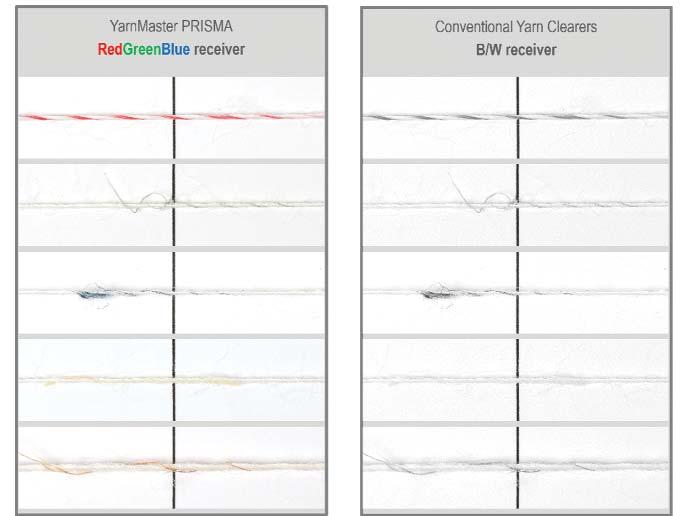
Figure 2: How foreign matter is seen by the sensors.

Features 38 PAKISTAN TEXTILE JOURNAL - October 2022
Figure 1: RGB color lightning within the clearing channel
Production optimization through a Cut History overview
The PRISMA operating system provides a Cut History in which the detected colors are displayed for each cut. This enables data-based decisions on quality–mill management optimization and helps to increase efficiency from the blow room to the winding machine. This unique feature provides important information about 100% of the spun yarn and opens up new possibilities in raw material selection, blending, and cleaning.
Only the necessary: Intelligent organic filtering
PRISMA’s uniqueness supports increases in efficiency with a holistic approach. The PRISMA software system uses algorithms and statistical models to analyze and draw inferences from data patterns, ensuring recognition of all possible organic matter.

In addition to color management, RGB technology enables color-oriented selection of organic material in the cotton yarn, which does not necessarily have to be removed, as it does not cause disturbances in downstream process steps and is eliminated by other means.
Loepfe has fed the system with thousands of samples of organics, showing what they look like and how
disturbing they are. The system can then recognize the organics without following explicit instructions, relying instead on the collection of organics and the patterns it has made from it. Customers can benefit from this intelligent organic filtering which offers an even more accurate detection of organic substances. The filter has learned whether organics need to be removed or not, leading to considerable savings, clearer cuts and higher winding efficiency. Machine learning methods take the organic clearing function to the next level.
Trials with several customers have shown that PRISMA is able to maintain yarn quality while increasing clearing efficiency through a lower cut-rate. This is achieved by the unique combination of software and precise and sensitive sensor technology which allows error-free detection and classification of disturbing or non-disturbing defects.
Focus on customer needs: Customer trial results
In production, certain parameters are given. The level of efficiency to be profitable and the level of yarn quality to guarantee flawless further production. Various customer tests have shown that the unique measuring technologies of PRISMA enables the producers to achieve a higher yarn quality at a fixed cut-rate, i.e. a fixed productivity level, or vice versa provides a higher productivity (lower cutrate) at a given yarn quality.
The graphic shows a test carried out with a customer in China manufacturing an Ne 60 compact yarn. Since the yarn quality now produced is not always satisfying, the goal was to reach a higher yarn quality while keeping the defined level of productivity (cut-rate).
The on-site test showed that the target – higher quality while maintaining the cut-rate – was met. This important production optimization was achieved by the more precise removal of colored foreign matter and fewer cuts on nondisturbing organic events. This result also achieves improvements in raw material utilization, since a higher quality could be achieved from the same raw material with the same cut-rate. The performance of PRISMA convinced the customer and leaves him room for further optimization of his profitability. This new and trendsetting innovation shows once again how further optimization of spinning mills can be achieved through 100% online quality control with the latest technology on the market.
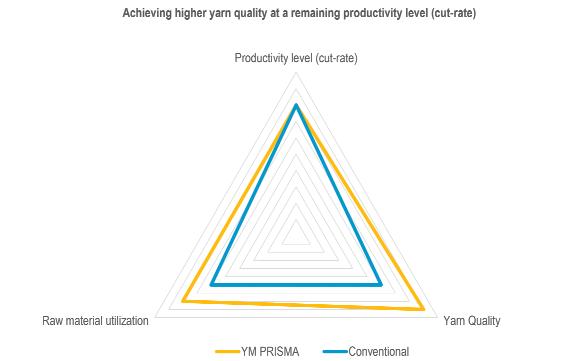
Features 39
Figure 3: Foreign matter color mapping. Figure 4: Customer test result
Swiss Textile Manufacturing –30 years of sustainable progress
Textile manufacturing in Switzerland has for many years now taken place with a strict emphasis on environmental responsibility – everything a manufacturing plant does is strictly regulated, including the land, water and air that is used. In many cases, these companies have had to meet standards even higher than in surrounding European countries.
As a result, the Swiss textile manufacturing companies were very early responders to the need for sustainable production and through close cooperation with them, many lessons
have been learned by members of the Swiss Textile Machinery Association in technology requirements.
Finishing machinery leader Benninger and process optimisation specialist Sedo, for example, are supporting members of bluesign, which is now a highly-successful independent environmental certification company.
Bluesign was formed following the successful conclusion of a project embarked on in 1997 – 25 years ago –when Swiss textile manufacturer Schoeller Textil embarked on a project to more closely control impurities in its
manufacturing processes from the outset and to ensure there was nothing in the final textiles could cause a problem.
RSLs
In other words, bluesign, Schoeller and its partners created the first restricted substance lists (RSLs) – something every brand relies on today.
In order to make this successful concept accessible to as many textile companies as possible globally, bluesign was then formed in 2000 with the goal of motivating suppliers, manufacturers and top brands to reduce the overall footprint

40 PAKISTAN TEXTILE JOURNAL - October 2022
of textiles, with a particular focus on the chemicals used.
Schoeller Textil became the first textile company in the world to receive bluesign certification in 2001 and was instrumental in establishing this highlysuccessful system. It excludes all environmentally harmful substances from the manufacturing process, sets guidelines and monitors their observance for environmentally friendly and reliable production.
Years before the REACH regulation went into force in 2006, bluesign laid the groundwork for its comprehensive chemical management with the most comprehensive RSL, which today includes over 900 chemical substances and approximately 600 substance bans.
Oeko-Tex
Even earlier than bluesign, the Zurich-headquartered Oeko-Tex Association was founded in 1992 to introduce one of the first standards for more responsible textiles – Standard 100. The Oeko-Tex Standard 100 label informs consumers that textile products have undergone laboratory testing for a wide range of harmful substances, and that the content of those substances remains
below the limit values established by the association.
The requirements for obtaining the certificate are updated at least once a year based on the latest scientific information.
The association has expanded over the last 30 years to provide a portfolio of certifications relating to various areas of the textile and clothing supply chain, and today over 21,000 manufacturers, brands and retailers in more than 100 countries work with Oeko-Tex to ensure their products are tested for potentially harmful substances. At the same time, millions of consumers around the world rely on Oeko-Tex labels to guide purchasing decisions.

Oeko-Tex offers standardised solutions that enable companies to optimise their manufacturing processes and help bring high-quality, sustainable products to market. The international, independent Swiss testing and certification organisation Testex, also headquartered in Zurich, is the official representative of the Oeko-Tex Association, with over 30 offices around the world.
Common goals
The progress of initiatives such as Oeko-Tex and bluesign has had a very positive influence on many members of the Swiss Textile Machinery Association over the past 30 years. They share the common goals of enabling the safest and most resource efficient and sustainable textiles to be produced anywhere in the world.

Special Reports 41
Cornelia Buchwalder, Secretary General, Swiss Textile Machinery Association (Swissmem)
Cotton Council International celebrates its third Cotton Day in Mumbai
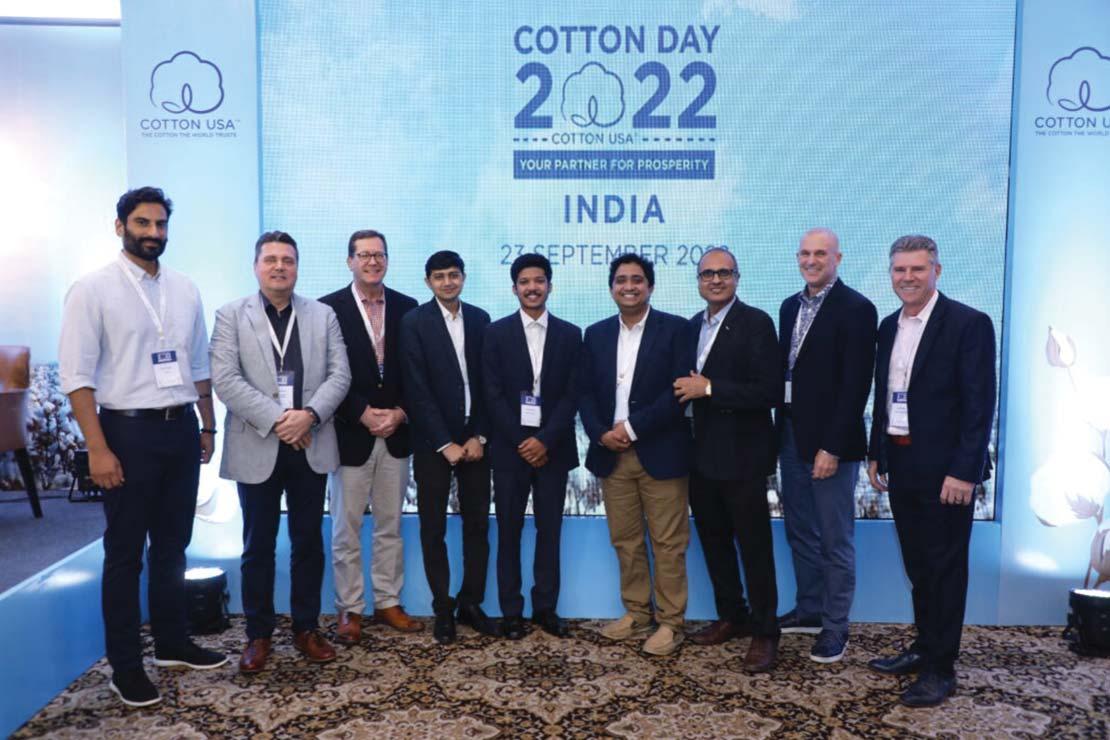
Focus on partnerships for industry growth
Cotton Council International (CCI), along with the leadership of the U.S. cotton industry, held its annual Cotton Day in Mumbai, India, educating over 120 attendees on how U.S. cotton adds value for its partners in the Indian textile industry. This year’s event, held both virtual and in-person, featured the theme “Your Partner for Prosperity”, bringing a fresh perspective from leading industry experts on how U.S. cotton connects the textile community and is a trusted partner in the textile supply chain.

“Accountability and transparency are integral to the U.S. cotton industry’s values,” William Bettendorf, Director, COTTON USA Supply Chain & South Asia, CCI, said. “Both brands and consumers today are increasingly
becoming more responsible in their sourcing strategies. Sustainability and transparency are the top priorities in our industry, and with a collaborative approach, we aim to add value for our partners.”
India is an important market for U.S. cotton; India’s forecast for cotton production shows an upward trend, with around 27.5 million bales (at a 480pound bale size) in 2022-23 as compared to last year’s total of 24.5 million bales.
42 PAKISTAN TEXTILE JOURNAL - October 2022
India’s mill consumption accounts for 21% of world’s consumption.
Peush Narang, CCI Country Representative-India and Sri Lanka, added, “The Indian textile industry is one of the largest industries in the country and has witnessed phenomenal growth in the last two decades in terms of installed spindles and yarn production.
Technology-wise, the Indian spinning industry has been able to keep pace with the international technology trends.
Cotton has been the growth engine for Indian textile industry, and India has become one of the largest consumers of
cotton, with about 22% of the world’s cotton consumption.”
Cotton Day India 2022 featured eminent speakers and panelists from the U.S. Embassy, CCI, and cotton industry experts from the U.S. and UK, along with allied companies that support the industry with traceability solutions.


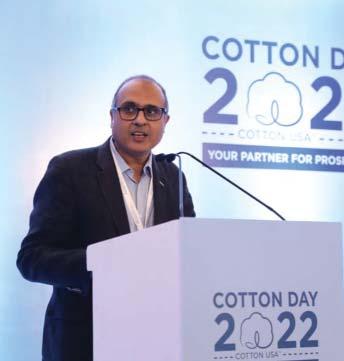

The event included insightful sessions on what the industry can do together to encourage partnerships and collaborative approaches for growth and prosperity. The event had sessions about the recent global cotton scenario, an update on
Indian cotton, risk management, the U.S. Cotton Trust Protocol® and how sustainability and transparency are defining future global supply chains. It also included the latest CCI updates and industry guidelines on how Indian textile mills could adopt COTTON USA SOLUTIONS™ best practices to help increase profitability.
Marc Lewkowitz, President & CEO of Supima, shared key updates on the Supima licensing program. Jane Singer, managing director of Inside Fashion, also spoke about trends in the global fashion industry.
Special Reports 43
A World without odors, Fight or Flight?
Archroma gathered three experts of Archroma and SANITIZED, our partner for antimicrobial and hygiene technologies, at the recent Techtextil exhibition in Frankfurt, Germany, to discuss odor management solutions for textiles. Also in focus: the brand new Sanitized® OX20, an odor neutralizing product out of the Sanitized® Odorex™ product family.
Odor management technologies are evolving from antimicrobials to biocidefree odor adsorbers technology. However, odor adsorbers may not be a suitable replacement for all applications, as the right technology will depend on the intended use, required performance or local regulatory context.
Nuria Estape, Head of Marketing for Archroma’s Brand & Performance Textile
Specialties business, moderated the discussion with the three experts: Georg Lang, Head of Competence Center Finishing, Archroma; Stefan Müller, Head of BU Textiles Additives Sanitized; Yann Ribourdouille, Global registration expert Product Stewardship, Archroma

Exerpts
The new biocide-free OX20 is a passive system. Could you explain the main difference in the mode of action of active and passive systems?
Stefan Müller: There are 2 ways to reduce or manage odors. One is the traditional antimicrobials, what we call the “active” approach. This is where the growth of bacteria is prevented or greatly
diminished by antimicrobial active substances. No bacteria means no option for bad smells to be generated.
The biocide free technology, which we call “passive” technology, are odor adsorbers. This technology works by adsorbing the bad odors due to a significantly bigger surface. The odor adsorbers have a certain adsorption capacity. Once this capacity is exhausted, they can be washed and will adsorb bad odors again.
Antimicrobials are dealing with the reason or source of bad odors, whereas odor adsorption technologies tackle the symptom.
Their mode of action is obviously different – antimicrobials hinder the growth of bacteria and prevents thereby malodors and other unpleasant smells,
44 PAKISTAN TEXTILE JOURNAL - October 2022
whereas odor adsorber technology adsorbs the odors before they are noticeable. As odor adsorbers need to be washed from time to time (to re-load the adsorbing capacity), they are ideally for sporting textiles etc. which are easy to wash. On the other side antimicrobials are to be used for applications with especially high hygiene requirements or items which are difficult to wash like shoes, various working clothes, or home textile articles.
Does an odor absorber technology reach the same effect as an antimicrobial treatment? How do you check the efficacy of both?
Stefan Müller: Different technologies for different applications / different test setups as well.
Test methods for active systems - The effectiveness of textiles equipped with active systems can be determined by quantitative antimicrobial standard tests (static contact tests), like ISO 20743, AATCC 100, JIS L 1902. All are based on the same principle and are suitable for non-leaching AM technologies. They also allow measurement against various relevant bacterial species (Gram Neg. and Gram Pos.). The textile samples are inoculated with a bacterial suspension and then incubated. After this contact time, the number of bacteria on the samples is quantitatively determined by plating on nutrient media plates. The difference between the values for treated and untreated textiles shows how many of the bacteria were reduced by the applied active substance. Another test method for the quantitative determination of antibacterial activity of textiles is ASTM E2149. In contrast to the previously mentioned methods, this is a dynamic contact test. This was developed specifically for substrate-bound active ingredients and is particularly recommended for silane-quat technologies.
Test methods for passive systems - In contrast, passive systems have no effect against bacteria, but adsorb their released odor. For this reason, a different measurement method is required. ISO 17299 can be used to determine the odor adsorption efficiency of a textile. Specifically, ISO 17299-3 involves placing a defined amount of isovaleric acid (responsible for body odor or perspiration odor) in a bottle together with the textile.
After reaching equilibrium, the amount of odor molecules is quantified by gas chromatography. By comparing this value with the initial concentration, the odor reduction rate of the finished textile can be determined.
Have you seen an increase of the demand of odor absorbers technology in the last years?
Georg Lang: Yes, there is a strong demand for an odor adsorption effect, mainly in the sportswear area, but also in leisure wear, underwear, and other areas where end consumers face the creation of unpleasant smells.
If course, there are some markets in which the alternative (odor adsorber) technology is not sufficient to meet the requested performance, for instance mattresses that cannot be washed or end-articles which require a treatment with antimicrobial products to prevent the growth of bacteria, molds or fungi. What is the evolution of the worldwide biocide regulations?
Yann Ribourdouille: There is an increasing concern from citizens and authorities about the risk and hazards for health linked to exposure to chemicals. This is especially true for biocide which by essence trigger effect on living organisms.
Due to that lot of countries either implemented new regulations or strength their biocide regulation with new data requirement e.g. the duty to inform user about hazard (labelling requirement).
We see this trend in Europe with BPR (2012) or US Federal Insecticide, fungicide, and Rodenticide Act (FIFRA) and all the new local biocide regulations that appear or will come soon like Korea (K-BPR in 2019) and partly in India.
Is there a difference regarding sustainability aspects between active and passive technologies?
As there are different substances are used in the active technologies, this can’t be answered in general terms. What can be said however is, that metal free technologies most likely win against metal technologies, as the mining of metals is a very energy rich process. Our actives are applied to textiles in very small amounts and are fixed on the textile so that they can withstand multiple laundries. Therefore, they add comparatively little to the CO2 Footprint of a clothing item. They can however
help consumers tremendously in saving energy, as odor management technologies enable that clothing can be worn longer before needing a wash, which results in less washings and therefore saved energy, water and washing liquid.
Active odor management technologies fight bacteria – how can be ensured that they don’t inflict harm on the wearer or processor of textiles?
Yann Ribourdouille: The biocide regulation allows only a selection of wellknown chemicals for specified uses. We can therefore ensure, that according to current knowledge our technologies do not pose a risk to wearer nor to processors if used correctly. Our role is to guide textile manufacturers in the best possible application process to protect the worker and the final user.
How many wash cycles can these finishes withstand? Is there a difference between active and passive technologies?
Georg Lang: We test for 50 home laundries. This is our benchmark for both technologies.
How do you explain the odor adsorption mechanism?
Stefan Müller: By applying our passive technology on a fabric, the specific surface of the fabric is increased substantially. This property leads to an adsorption effect of odor which can be measured by GC-MS. In principle the surface is a sponge-like structure that catches odor molecules. The odor molecules in the sponge-like structure will be released through home laundries.
Can we expect more novelties in the odor management field in a short future?
Stefan Müller: Our approach is to develop global technologies, but we’re open as well to solve local market issues, like for example the demand for ammonium adsorber technologies in China.
In China, customers want an odor adsorber, which not only works for IVA (isovaleric acid) but also for NH3 (ammonia). This needs other technologies. Another field we look into is the development of natural based odor adsorber technologies. In this context we’d like to point out that our main focus remains on the reduction of body odors.
Special Reports 45
“Stäubli creates new benchmarks with high-performance textile machinery ”

What areas of activity are covered by the Stäubli Group? What range of solutions does Stäubli offer to the textile industry?
With its four divisions – Fluid Connectors, Electrical Connectors, Robotics, and Textile – the Stäubli Group serves a great many industrial sectors. We are an international group that operates its own business units in 29 countries and collaborates with agents in 50 countries on four continents as well. Our global workforce of 5,500 shares a commitment
Mr. Fritz Legler – Division Marketing Officer, Stäubli Textile
to partnering with customers to provide comprehensive solutions and long-term support.
Our two Connectors divisions cover connection needs for all types of fluid, gas, electrical, and data systems. Our Robotics division is a leading player around the world in industrial automation, including solutions for the food and pharmaceutical industries. And our Textile division is a leading global supplier of shed formation solutions for the weaving industry. We provide cam motions, rotary dobbies, and Jacquard machines for all
sorts of weaving applications. Our Textile product range also includes automation solutions for weaving preparation, like warp tying and warp drawing-in systems – for example, SAFIR automatic drawingin machines – to enable efficient style changes and ensure the best quality in the downstream weaving process. We also offer complete weaving machines like the double-rapier ALPHA series for face-toface carpet weaving and our TF series for technical textiles. These provide unlimited design options and enable 3D-weaving.
46 PAKISTAN TEXTILE JOURNAL - October 2022
Interview
Tell us about the vision and the core strengths of Stäubli that give it a unique competitive advantage.
Stäubli is a pioneer in mechatronics, with a proud engineering heritage and over a century of experience. We are also a forward-thinking organization on a continual quest for the next great innovation that will help our customers work more productively, efficiently, and sustainably. As a long-term partner, we serve customers worldwide who aim to increase their industrial productivity without compromising quality, reliability, or safety. Examples of solutions that we have refined over the decades are our S3000/S3200 electronic rotary dobbies and our LX/LXL/LXXL Jacquard machines. These are renowned worldwide for their long service life, exceptional precision, and reliable operation at extremely high weaving speeds. We have also developed unique automation solutions for warp preparation. Our drawing-in machines are used by virtually every leading weaving company in the world.
How has the Jacquard machine evolved, and how has it affected the textile industry over the years?
Jacquard machines, along with electronic cam motions and rotary dobbies, are central in Stäubli’s range of shed-formation solutions. Our first one marked a key moment in Stäubli’s history, and the second one was a major technical advancement. Jacquard machinery was integrated into Stäubli many decades later, actually in 1983, when Stäubli took over the activities of the century-old company Verdol.
Verdol was a French company situated in the heart of the area where weaving was revolutionized by Mr. Jacquard and by the Italian Tagliabue brothers. Once within the Stäubli Group, with its competencies in electronics, Jacquard weaving was revolutionized in 1987 when Stäubli presented the CX 860 at the ITMA in Paris. This was the world’s first electronically controlled Jacquard machine. Jacquard machinery is a very important part of the textile industry. Stäubli is the leader in this market, with several thousand machines produced each year. Stäubli machines can weave a wide variety of fabrics, from clothing fabrics to interiors fabrics, toweling, ribbons or labels, and technical fabrics like OPW (one-piece woven) airbags. By the way, Jacquard fabrics are not printed, so they can be completely recycled at the end, without losing material or producing waste.
What new technological developments does Stäubli offer that can give weavers a competitive edge?
The first one that comes to mind would be the new-generation SX PRO Jacquard machine, which was launched at the ITM 2022 trade fair in Turkey in June. Equipped with up to 2,688 hooks, this machine answers the market’s demand for better power efficiency and lower energy consumption. It incorporates all of the proven technology of Stäubli’s predecessor Jacquard machines and it features a number of innovations to reduce energy consumption: low-friction design of the MX PRO module, a power supply fully integrated into the machine itself, and a new ventilation system with optimized temperature monitoring. In combination with the new TC8 Controller, the Stäubli SX PRO can operate under extremely challenging conditions with reliability and resilience, even at high weaving speeds.
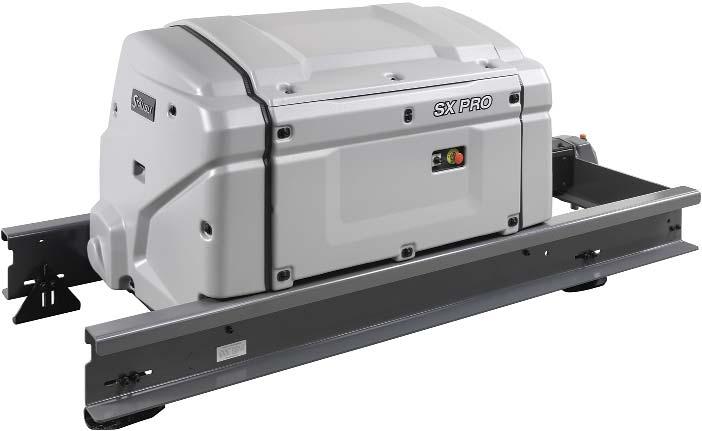
One step ahead of weaving, Stäubli lays the basis for an efficient overall weaving process. The broad range of automation solutions for weaving preparation includes SAFIR automatic drawingin machines that enable an overall fluid workflow in the weaving mill – not only in the drawing-in department but in the weaving process itself. There are also convincing solutions for fancy yarns like elastic yarns for mixed denim warps, for cotton, filament, and even very fine glass yarns. State-of-the-art Active Warp Control technology features like optional repeat management enable perfect

Interview 47
SAFIR S40 automatic drawing-in machine.
Stäubli SX PRO can operate under extremely challenging conditions with reliability and resilience, even at high weaving speeds.
preparation of top-quality multicolor warps, even without a lease. Stäubli continuously adapts its machinery to market demands, and we recently introduced offset management for double warp beams. This allows easy adjustment for offset and enables the highest drawing-in speeds. By employing the most advanced sensor, optics, pneumatics, and software technologies, Stäubli stays ahead of the curve.
What are Stäubli’s key markets?
Stäubli has been doing business in Pakistan for a very long time; how important is this market for the company? Tell us about your agent SIMAG in Pakistan?
Pakistan is unquestionably a key market for our Textile Division. We have a strong, long-standing partnership SIMAG, our local agent in the country. SIMAG is a recognized local leader in the field of textile machinery representation. Working closely together, we make a very strong team, and we successfully meet the many various needs of our weaving customers.
Other key markets for us are the main textile manufacturing countries around the globe. We maintain a strong presence
everywhere, and we continually strive to remain close to our customers.
What current challenges does Stäubli face, and how do you plan to meet them?
I think we’re in the same boat as everyone else – we are dealing with supply-chain disruptions, currency distortions, limited market access in some areas due to pandemic, and drastic cost increases caused by these and other factors. Consumers have to absorb a lot right now. Let’s keep our fingers crossed that they stay positive and confident despite the global situation.
How was your participation at ITM and Techtextil? What are your expectations regarding IGATEX 2022 and ITMA 2023?

ITM 2022 was our first opportunity for face-to-face interaction with our customers after the pandemic restrictions were eased. It exceeded our expectations in terms of visitors and interesting discussions and projects. The ITM trade fair has become a hub in the Middle East, underscoring the importance of Turkey as a major manufacturer and supplier to
Europe and the USA. Suppliers throughout the entire textile value chain were present at the event in strong numbers.
Techtextil Frankfurt reconfirmed its status as the global trade fair for technical textiles in terms of exhibitors and visitors, although visitors from certain Asian countries were absent. Interesting applications were exhibited, and new applications were addressed. Many steps toward sustainable solutions in construction, aeronautics, automotive, and medical technology were to be seen. The trade fair was as interesting as ever.
Due to various issues like the pandemic, visa restrictions, and so forth, ITMA Asia is still considered a regional trade fair. Nevertheless, it will still be very important for the Chinese textile production market, which is a global leader.
Regarding IGATEX in Pakistan, Stäubli shall highlight for Jacquard weaving: the brand new SX PRO Jacquard machine and few other state of the art technologies. When it comes to ITMA 2023, this mega trade fair for the global textile industry is in preparation. Here at Stäubli, we are already gearing up for it. We are looking forward to presenting some very interesting developments and innovations!.
Interview
48 PAKISTAN TEXTILE JOURNAL - October 2022
Stäubli Textile Textile Communication Officer Summer Hsia and Stäubli Textile Global Head of Marketing, Sales and Service WPS Fritz Legler

Unique waxed cotton finishing with new Monforts line
Monforts has installed and commissioned a new Montex finishing range at the Baltic Works of Halley Stevensons in Dundee, Scotland, to further boost the weatherproofing specialist’s highly flexible operations.
The range, with a working width of two metres, was built at the Montex assembly plant in Austria and consists of a Montex®Coat coating unit in knife execution for paste and foam coating and a Montex 8500 6F stenter.
Unique know-how
Founded in 1864, Halley Stevensons has amassed unique technical know-how and manufacturing experience in the art of waxed cotton for weatherproofed fabrics and is able to provide international orders in custom colours and finishes to very low minimum quantities where required. The company exports worldwide and its premium brand
customers include Belstaff, Barbours, Filson and J.Crew.
“Our team of skilled technicians is constantly striving to develop and refine new and existing products in terms of colour, handle and performance and we regularly design and build our own bespoke machinery to give us optimum manufacturing capabilities,” says Managing Director James Campbell.
The new range draws on all of the latest advances and technical expertise of Monforts gained from countless installations around the world, allowing Halley Stevensons to pigment dye, direct coat and pad apply finishes and offering more scope for R&D.
Lifeblood
“R&D is the lifeblood of our business,” says Campbell. “The precise process control functions of the line give

our technicians confidence to make new products as well as finely tuning the energy requirements of existing products. We love the fact that we can record the energy used on each production batch and use this for continual improvements and efficiency savings. The touchscreen software is visual and easy to use, moving from one screen to another to check the various parameters of processing.”
The range has replaced one of the company’s older stenter/coating lines and has already enabled Halley Stevensons to recreate various products with lower coating applications at higher speeds than was previously possible.
“Many refinements have been made to the Montex®Coat in the past few years, resulting in higher coating accuracy and the resulting quality of the treated fabrics,” says Monforts engineer for textile technologies Alexander Fitz, who has been working with Halley Stevensons
50 PAKISTAN TEXTILE JOURNAL - October 2022
Halley Stevensons Managing Director James Campbell at the controls of the new Montex®Coat.
on commissioning of the range and new product trials. “Monforts is the only manufacturer to offer completely integrated coating lines from a single source and the coating machine is tailored to the subsequent Montex drying technology – with all the benefits resulting from fully integrated plc control.”

“Since we last purchased a stenter, the advancement of the technology on the Montex has been vast, especially in burner and air extraction,” adds Campbell. “The machine is also very robust – especially the chains, which need very little lubrication and will last us a long time. We have been pleasantly surprised how quickly we can move from say, a 100gsm fabric to a 600gsm fabric, with no requirement to adjust tensions.”
Sailcloth heritage
Waxed cotton was originally developed by sailors in the early 15th century when Scottish North Sea herring fleets began treating flax sailcloth with fish oils and grease in an attempt to waterproof their sails. Remnants of these sails were used by the sailors as capes to withstand the high winds and sea spray.
By the mid 1850s, sailcloth was being treated with linseed oil, but while initially
highly effective, it would yellow and stiffen through weathering over time and eventually lose its waterproofing qualities.
In the years that followed, various treatments were applied to cottons in an attempt to find the most effective weatherproofing solution, and the combination of densely-woven cotton impregnated with a paraffin waxed coating proved most successful. For over 150 years, Halley Stevensons created many different variations of both woven constructions and finishing treatments and now supplies thousands of metres of waxed cotton every year, with each roll produced to custom specifications.
Durability
“The beauty of waxed cotton is its durability and longevity,” says Campbell. “The fabrics are breathable, with the wax adjusting to ambient temperatures to be softer and more breathable in warm weather and stiffer and more wind proof in cold conditions.”
While traditional waxes are petroleum or paraffin based, Halley Stevensons has always been comfortable about using a waste product from industry and reusing it to make products that last a lifetime.
“We are always exploring different finishing techniques and one of our most
popular finishes is our hybrid aero – an emulsified blend of waxes,” Campbell says. “This fabric is water repellent but has little wax in the mixture so the handle is much drier to touch than the traditional wet waxes.”
The company has also recently launched a new 100% plant-based wax –Ever Wax Olive – consisting of a blend of olive oil, rape seed and castor bean with comparable water repellence to petroleum and a far better rating than other natural waxes which have come before it.
Benchmark
“The high tradition of skills and fabric innovation imposed by our original guildsmen is still our benchmark standard of honest workmanship today,” Campbell concludes “We use responsibly sourced cotton fabrics and processes that are gentle to the product and low impact to the environment. Our dyeing methods use very low levels of water and our waxes are simply heated up for application and cooled down to store when not in use, meaning no waste discharges. Now, with this new Monforts line, we are also achieving running speeds two-to-three times faster than with the older stenter, combined with less gas usage. It’s proved a great partnership.”
51
Dyeing Printing Finishing
Scottish weatherproofing specialist Halley Stevensons has considerably expanded its options with the new Monforts line.
AQUARIA® offers limitless potential for after-printing washing process
Thousands of meters. The tests Biancalani has taken on printed fabrics are further evidence of the versatile nature of AQUARIA®.
In fact, the machinery does not aim at a single kind of after-printing washing process, but it has shown its limitless potential, its several applications.
That is why, it is totally makes sense to call AQUARIA® a textile finishing machinery with benefits.
Quality check
What seemed like an interesting number of very good results have underwent quality checks by external laboratories, which have done nothing but confirm those results, obtained by Biancalani during the last two years.
After-print washing by AQUARIA® ensures extreme colorfast fabrics during the washing process. Besides, it astonishes the cleanliness of fabric fibers and yarns washed by AQUARIA® – both printed and to be piece dyed ones –which are totally free from the residues of chemical additives used during the spinning and weaving processes.
R&D
When creating what represents a breakthrough in the textile industry, thanks to an innovative machinery, it is essential both to have a deep knowledge of what is already on the market and to start a close synergy between the R&D department and highly prepared and experienced external experts. “After working for years in the mechano-textile industry and particularly in the segment of washing” a textile specialist states, “I’m very impressed that I’m face to face with a machine I’ve never seen before, a real step forward in the textile field of washing after printing.”
Benefits
The benefits of AQUARIA® as the ultimate after-printing washing machinery should not be surprising as at its core there’s the renown AIRO® process. Thus, fabric is moved by air and thanks to the intense mechanical action resulting from special grates flapping – patented by Biancalani. That’s what R&D also means: to find a connection between what you have already achieved and what is still to be achieved, in order to make the best out of it.
Fine facts and numbers, but how does after-printing washing process by AQUARIA® actually work?
The machinery is composed two modules that can be combined in a line. AQUARIA® main module takes care of the fabric, moving it back and forth alternately and pushing it thanks to an airflow blended with washing. That guarantees the ultimate combination of mechanical action and long dwelling times. The auxiliary module alternates between different phases, i.e. washing and rinsing.
Speeding up the washing process and thus reducing production time, AQUARIA® module can become the core of a three-modules after-printing washing line (pre-washing module + AQUARIA® + rinsing module). The AQUARIA® line can guarantee an increased productivity, up to 50 meters per minute, and confer to the fabric a unique hand, very different from fabrics finished using traditional machinery.
AQUARIA® limitless potential is totally ready to be discovered.

52 PAKISTAN TEXTILE JOURNAL - October 2022
Dyeing Printing Finishing

BRÜCKNER Textile Technologies and HEATHCOAT FABRICS –the journey continues

HEATHCOAT FABRICS partnered again with BRÜCKNER Textile Technologies / Germany and their sales partner ADVANCED DYEING SOLUTIONS to install a state of the art BRÜCKNER finishing line for industrial textiles.

HEATHCOAT FABRICS are at the leading edge of textile engineering. They have a proud heritage spanning over two centuries and are a global market-leading technical textile manufacturer with internationally recognised expertise in texturising, weaving and warp knitting as well as dyeing and finishing. HEATHCOAT’s highly specialist products are manufactured for use in the automotive, healthcare, defence, and aerospace industries, to name a few, contributing to some of the most innovative fabric-making projects in the world.
BRÜCKNER worked extensively with the local HEATHCOAT project team during several project reviews to develop a customized multipurpose finishing line, designed especially for the needs of HEATHCOAT FABRICS. The requirements were the treatment of light weight parachute fabric, but also heavy duty conveyor belt carriers as well as 3D warp knits and stretch sensitive microfiber fabrics, where even a human skin contact could create picking issues.
Mrs. Regina Brückner, CEO and owner of the BRÜCKNER Group stated: "To meet the complex requirements of HEATHCOAT is not easy because of the great variety of technical textiles produced. Our line has to finish light as well as heavy articles, so the design, control and the whole line layout have to be flexible, functional and still easy to operate. Fortunately, the team at HEATHCOAT FABRICS is very innovative and open-minded, and together we worked hard to develop the right technology and handling. We are very happy that we could convince this customer, whom we appreciate very much, with the productivity of our line and of course with our technological know-how."
The direct gas heated BRÜCKNER POWER-FRAME stenter with its unique staggered heating source arrangement every half zone provides best available temperature consistency across the length and the width of the stenter. The unit is equipped with a low-lub, horizontally returning combined pin / clip chain and several fabric paths, especially designed for the different fabrics being processed. Together with HEATHCOAT FABRICS technologists, the BRÜCKNER design team developed a very special delivery end of the stenter with different edge trimming and slitting possibilities.
Depending on the kind of products, the fabrics can be batched on large diameter A-frames, wound on cardboard tubes or plaited into trolleys.
Due to the complexity of the fabrics, the stenter is equipped with the newest weft straightening and pick counting technology. The control system allows integration into the customers ERP system and enables easy and reproducible operation by using the latest bar code scanning and batch related quality reporting tools.
Due to the increasing energy prices, it is mandatory that the machine is equipped with the state of the art BRÜCKNER heat-recovery technology.
Cameron Harvie, HEATHCOAT’s managing director says: “We are very happy with the work and dedication of the whole BRÜCKNER team. This includes particularly the BRÜCKNER technicians. Since the installation of the line started with the Covid Lockdown, the BRÜCKNER technician had to sleep in a camper in our parking lot for several weeks. Despite these unusual conditions, the assembly could be completed on time. The machine is producing to our complete satisfaction and overcomes all the challenges presented by our very different quality products."
54 PAKISTAN TEXTILE JOURNAL - October 2022

Demsan - Leading manufacturer of textile machine
Demsan one of the leading manufacturers of textile machines is operational in Turkey since 1978. The company started manufacturing precision plating machine and now have reached the level of manufacturing about 11 different types of machines.
Demsan cares about customer requirements and makes sure that their product quality should remain constantly on the higher side. With strong research and development, the company is continuously working for further quality gradation of their machines.
Demsan is been long associated with home textiles for many generations. Keeping the tradition of always serving its consistency, Demsan today is one of the horizontally integrated companies in the industry.
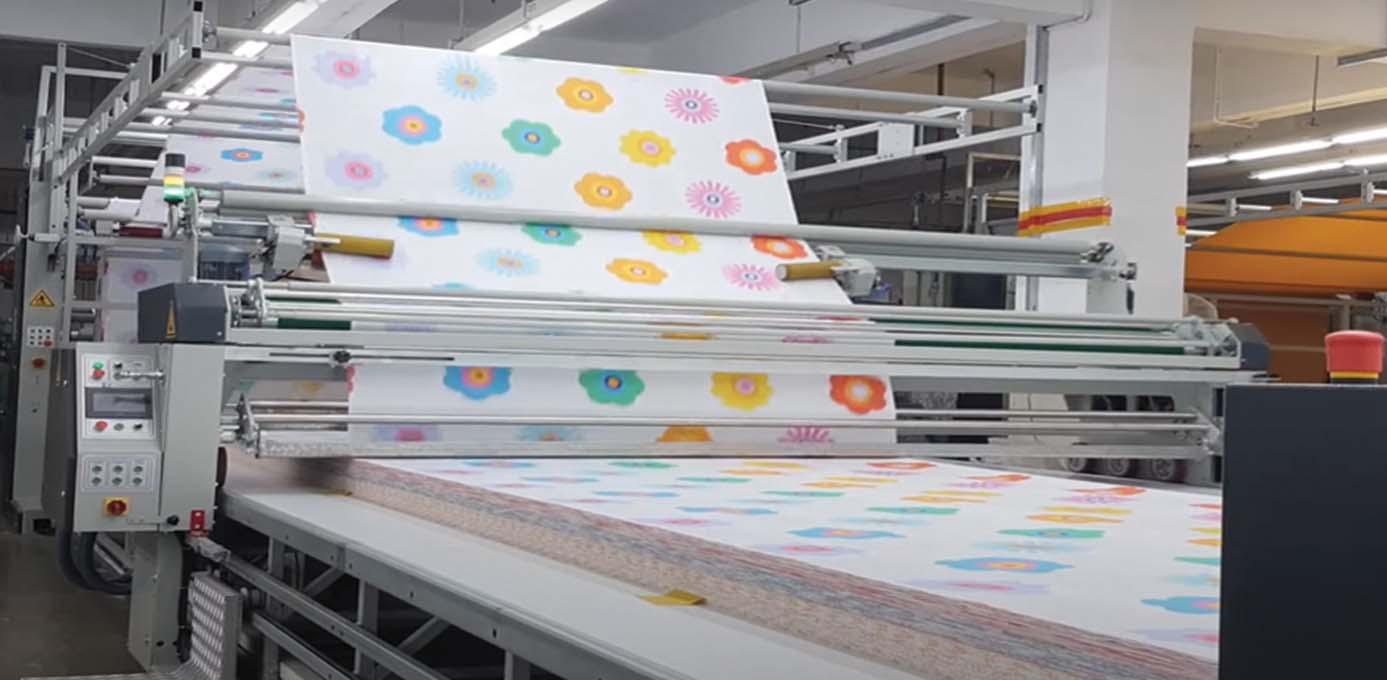

With years of experience and expertise the company now proudly owns several hundreds of satisfied customers that are running Demsan machines in Turkey as well as in other parts of the world.
For the last few years, the company has focused on the Asian market along with the middle east and European countries and has got an excellent response.
Pakistan is considered one of the major markets. Demsan has earned a lot of success in Pakistan in a comparatively shorter period. Zakaria Trading International is the top and most appreciated agent of Demsan in Pakistan.
Demsan Makina has introduced FABRIC SPREADING MACHINES, entry with Batcher, which makes this machine different from their competitors. Besides getting high production, it has a unique EYE SYSTEM for fabric edge accuracy. Already sold a Fabric Spreading machine to Lucky Textile and Liberty Mills - Karachi. Customers are very much satisfied and have got repeat orders from them.
Not only the Fabric Spreading machine, but DEMSAN MAKINA has upgraded their traditional PALLETIZING MACHINE with the servo control system.
Several machines are running in Karachi, Lahore and Faisalabad.
Uptill now more then 100 machines have been sold to some of the following respected customers: Indigo Textile, Soorty Enterprises, Rajby Textile, Siddiqsons, Rizwan Enterprises, Union Fabrics, Bhanero Group (Faisal Weaving) Sapphire, Nishat Bikki, Liberty Mills Ltd, Artistic Milliners, Maksons, Naveena , Luckytex, Zaman Textile, BB Jan, Lucky Textile, etc.
56 PAKISTAN TEXTILE JOURNAL - October2022
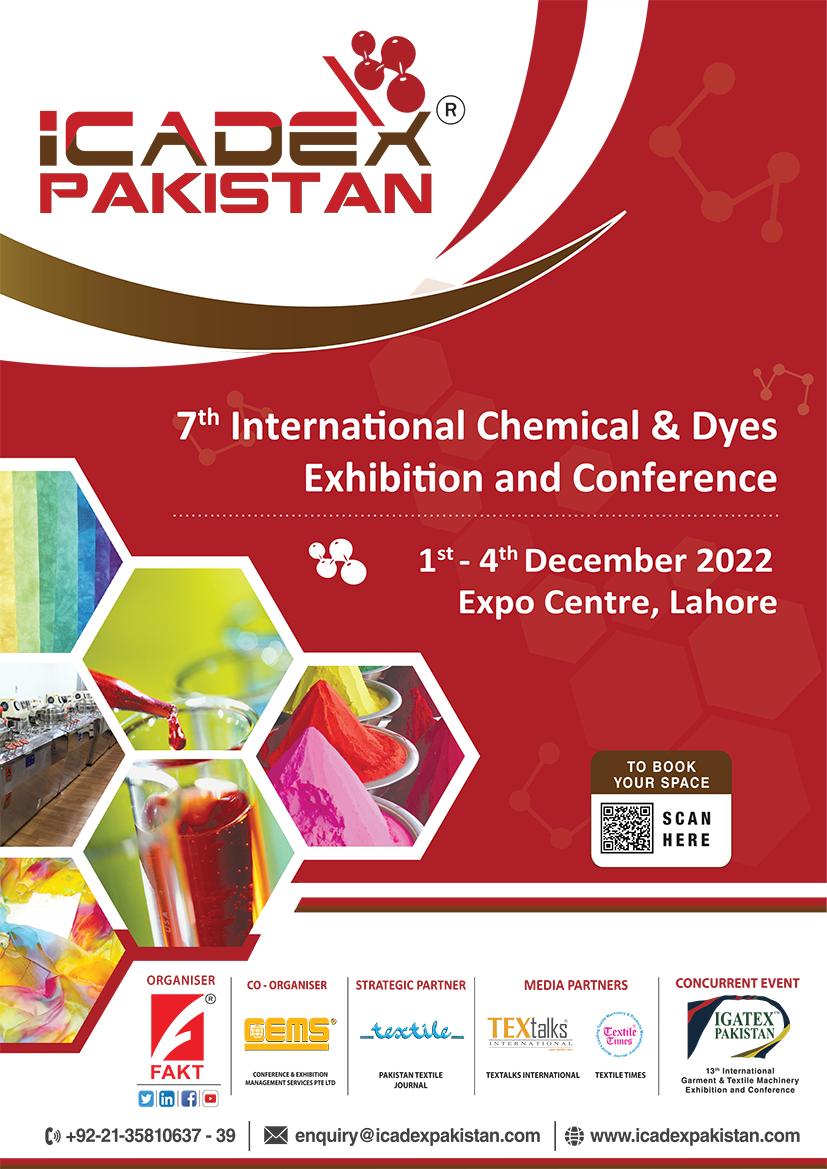
Jeanologia empowers a new generation of tech artisans at DenimandJeans Japan
Jeanologia, the leading Spanish company in the development of eco-efficient technologies, is promoting a new generation of technological artisans in the textile industry at Denimandjeans Japan 2022, connecting the unique Japanese denim culture in the world of authentic and exclusive vintage denim with a more efficient and sustainable production. (Booth 18).
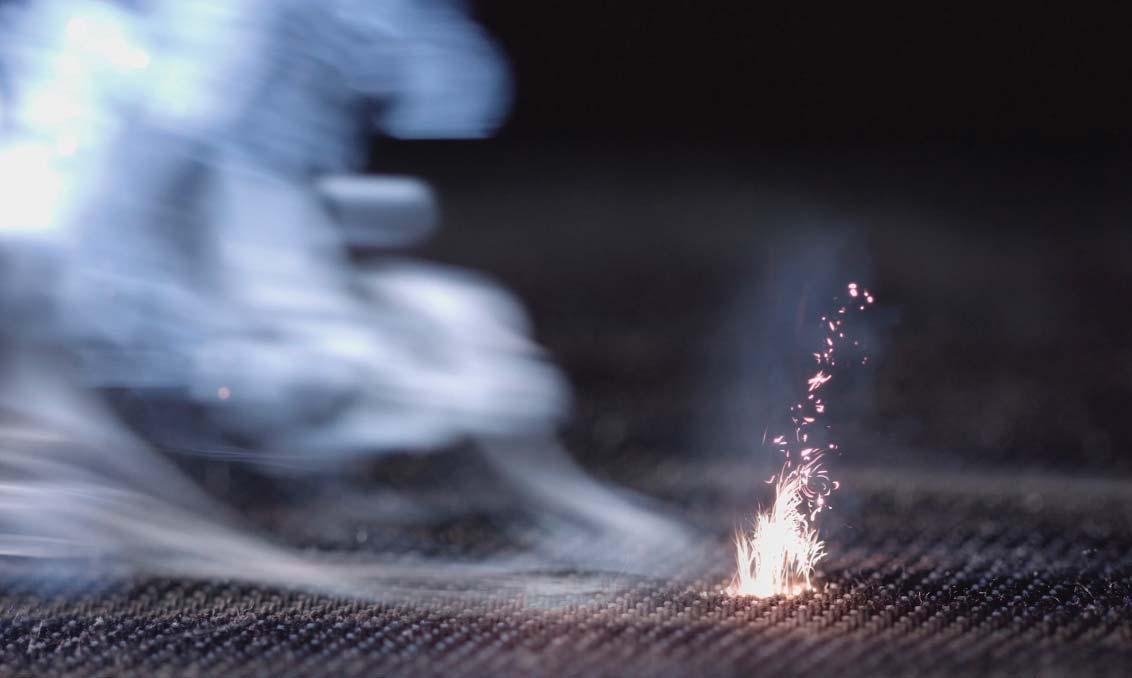
For Jeanologia, Japan is a cradle of craftsmanship and tradition that has managed to position itself as a world power in denim production. Akihiko Kashino, Area Manager at Jeanologia in Japan, highlighted that "Japanese denim artisans have been able to confer great quality, durability and attention to detail to jeans."
He expressed the need to promote a new vision of craftsmanship in the denim industry, which combines the past and the future to create handcrafted products
using modern techniques and in a simpler, more efficient and sustainable way.
“At Jeanologia we want to foster a new generation of technological artisans, of Japanese denim artists who are inspired by tradition, maintaining the spirit and soul of the artisans, but who, at the same time, use modern tools to create handcrafted garments under new parameters of efficiency and sustainability” – pointed out Kashino.
In his opinion, the future of fashion and design is the alignment of beauty and the planet. That is why, at the event, which takes place from November 1 to 2 in Sunshine City (Tokyo), Jeanologia will accompany artisan designers of the future with sustainable production models and technologies. "With the integration of our technologies we enable the production of exclusive, authentic looks with premium finishes, raising
craftsmanship to a new level" - he emphasized. He further stressed that "the combination of the most advanced technologies together with traditional appearance and techniques give denim a modern and unique vision."
In line with this, Jeanologia's “MissionZero” is framed to completely eliminate the use of water and discharge from the global production of jeans, without sacrificing their exclusive and authentically vintage look.
Sustainable technologies for new premium craftmanship
The Area Manager at Jeanologia Japan highlighted how the company puts technology at the service of creative artisans to digitally and individually produce exclusive and personalized garments geared to suit the consumer, reducing operating costs while improving polluting, harmful and inefficient
58 PAKISTAN TEXTILE JOURNAL - October 2022
processes. The company thus promotes the creative freedom of artisans, helping them combine their art with care for small details to achieve authentic and unique products through simpler, more efficient and sustainable production.
In consonance with this, he specified new laser technology used to achieve a perfect replica of vintage looks and introduce new ways for creativity and customization. A technology that also eliminates processes that are harmful to workers, reduces costs and improves environmental impact.
Likewise, he has also highlighted their e-Flow technology as another great ally of the textile industry since it uses air nanobubbles instead of water for the application of chemicals, or the use of ozone for the treatment of garments. The G2 technology uses air from the atmosphere and transforms it into ozone to give the garment a natural aged look through a zero-discharge process.
Among other Jeanologia technologies, e-Designer also stands out, with its cutting-edge software that allows the virtual production of a garment with infinite creative possibilities in a matter of minutes, simplifying the design process and reducing samples by 80%.
“Simplify Excellence” Seminar
On November, 2nd at 03:00 pm, the Area Manager of Jeanologia in Japan will give the "Simplify Excellence" seminar where he will explain why creativity, sustainability, digital transformation and technology are the keys to the new textile era. At this seminar, Akihiko Kashino will reveal full details of Jeanologia's new production model that
takes denim finishing into the sustainable and digital age.

Over 25 years working for the world
Since 1994, it’s been Jeanologia's primary mission to create an ethical, sustainable and eco-efficient textile industry, ushering in a new era through sustainability, digital transformation and automation. The company leads industry transformation with its disruptive technologies: laser, G2 ozone, e-Flow, SmartBoxes, Colorbox and H2 Zero, all of which are capable of increasing productivity and reducing costs, water and energy consumption, as well as eliminating harmful emissions and discharges while guaranteeing zero contamination.
With a team made up of 220 jeanologists of 26 different nationalities,
Jeanologia has 10 subsidiaries and exports its products and services to 72 countries on five continents. More than 35% of the 5 billion pairs of jeans produced each year worldwide are made with its technologies, and it has become a trusted partner of the market’s main brands.

Printing Finishing 59
Dyeing
Makroser Tekstil’s carpet production soars with a Mimaki TS300P-1800
Turkish company, Makroser Tekstil specialises in manufacturing digitally printed carpets and over the years has become one of the leading suppliers in the sector. Utilising Mimaki’s high-performance TS300P-1800 sublimation transfer printer since 2020, the company has optimised their production potential to meet increasing customer expectations in this growing digital textile carpet market.

Makroser Tekstil has become one of the leading brands in the carpet market with its expanding digital product range and increasing production capacity.
Established in Istanbul at the end of 2016, Makroser Tekstil serves as a raw material supplier in the supply chain, a manufacturer of carpets and home textiles and carries out studies for the development of the digital printed carpet industry. The company invested in a Mimaki TS300P-1800 sublimation
transfer printer in August 2020 and with it gained a significant competitive advantage in the digital printed carpet business.
Alongside carpets, the company also offers other solutions to the carpet industry by producing backing and other materials. Makroser Tekstil’s co-founder, Talha Güldeste explained, “As a company of 250 employees, we have positioned ourselves as a comprehensive manufacturer in the supply chain. We started to produce intermediate goods and materials that we use in the production of digitally printed carpets ourselves, and then sell them on to other carpet manufacturers.”
Acting as both a seller and a supplier, Makroser Tekstil has an approximate monthly output of 150,000 square meters of final product and sells about 70,000-80,000 square meters of intermediate goods per month. “Our
market has four main pillars, including chain market groups, export, e-commerce and our own retail network. We have gained serious momentum in the sales of our final products in recent years, and we attach great importance to our sales and marketing processes, in addition to production, so to increase our profitability. We are currently exporting 35-40% of our production, and our branding and e-commerce activities show that we are making significant improvements,” said Güldeste.
A new era of carpet production
Talha Güldeste’s area of expertise is in digitally printed carpets, a market that he has seen remarkable growth in over recent years. Observing the wider industry, Güldeste said; “Digitally printed carpets have succeeded in getting ahead of woven carpets with their ease of use, low cost, and plenty of colour and
60 PAKISTAN TEXTILE JOURNAL - October 2022
Talha Güldeste, Founder of Makroser Tekstil, in front of the Mimaki TS300P-1800.
pattern options. The consumption habits of our society have changed. Previous generations used to buy thick woven carpets and use them for 20-30 years, as an insulating material in homes. However, due to the widespread urbanization and natural gas infrastructure, the need for carpets to insulate the home has disappeared. We are now in a period of faster consumption, and low prices have increased the interest in these products, alongside them being much easier to maintain. The carpet now stands as a decorative element in homes and living spaces, to be changed seasonally or to match with the interior design.”

Opting for a Mimaki TS300P-1800 to reach top tier quality
Makroser Tekstil decided to invest in a Mimaki TS300P-1800 sublimation transfer printer back in August 2020, with the aim to strengthen their position in the digitally printed carpet market. “The investment in the TS300P-1800 has enabled us to have the capacity to respond quickly to e-commerce orders,” Güldeste commented. “Product quality is the main criterion in the supplies we provide to both online and retail outlets. We made this investment because we
saw that we would increase our quality and customer satisfaction in the carpets we print. The Mimaki printer met our expectations, providing the results we wanted from the very first print after installation.” Considering the increased demand, Güldeste aims to further boost their printing capacity with investment in several more Mimaki printers.
Güldeste noted that the quality and consistency of the colours and patterns they see in digitally printed products, no matter how much time has passed. “We have not seen differences between patterns, whether they have been printed once or a thousand times. Knowing that we’ll be able to print in the same colour and quality each time, we are able to meet the increasing quality expectations of our customers, while freeing us from the need of keeping stock in this process.”
Efficient printing was also a key consideration as the company looked to up the speed of production, Güldeste added, “Along with consistent quality, the safe operation of the machine, ease of use and maintenance were also incredibly important to us, and we were conscious of how problems, such as print head clogs, could hinder our work. The
TS300P-1800 is a tireless machine. Mimaki’s core technologies allow for uninterrupted printing and have made managing multiple printers with a single operator and computer so much simpler, saving the company both time and money. We have not encountered into any problems, even when the machine is running 24 hours, allowing us to respond quickly to demand and ultimately giving us greater profit in the long run.”
In addition to the printer itself, Makroser Tekstil uses original Mimaki ink in the printer, which has helped the company optimise its ink consumption. “While it is necessary to use 4 ml to print one square meter of paper with a similar ink, we can easily do the same with 2 ml of Mimaki ink. We have reduced our ink consumption by 30%, all while maintaining our print quality. As well as saving on cost, Mimaki’s inks are certified to be harmless to human health and environmentally friendly and made incorporating them into our production line a clear choice,” added Güldeste.
“Mimaki has made a great contribution to our growth plans in the coming period thanks to the printing technology. With it at our disposal, we feel encouraged and able to grow in our current market as well as to enter new application areas.”
61
Dyeing Printing Finishing
Makroser Tekstil has become a leader in digital printing carpets and other solutions for the Turkish and international market.
Tonello: New O-Zone cabinet
In 2021 the ozone revolution takes another decisive step forward with OZone, the new static cabinet designed by Tonello and developed in collaboration with Candiani Denim, which, by using only ozone, allows to obtain unique and customizable aesthetic effects such as localized fading and lightening, through an innovative, sustainable and responsible process.
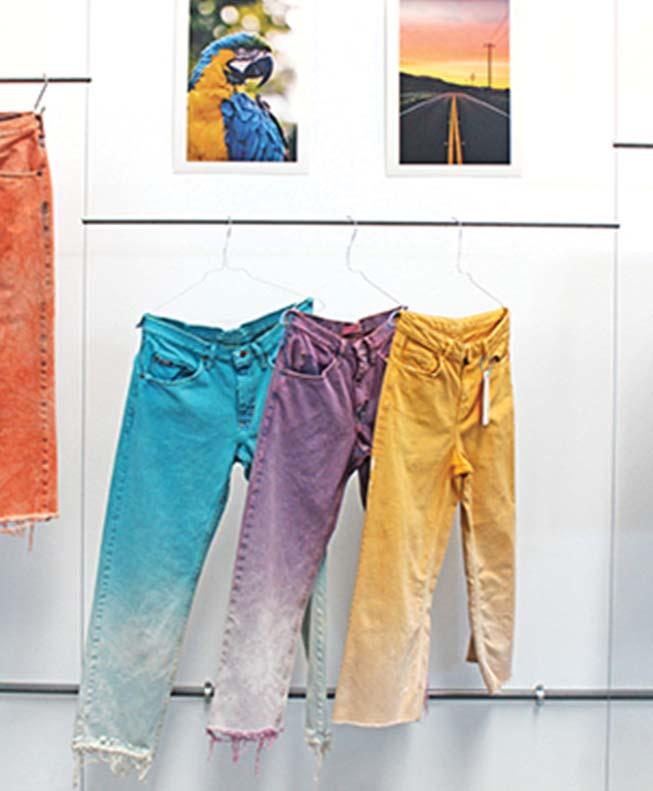
Designed for small productions and ideal for experiments and research directly on the garment, O-Zone makes possible new incredible aesthetic effects, such dégradé and sun-faded effects, through a flexible, fast, safe process that can be fully controlled via touch screen.
In short, we locked creativity in a cabinet. Freeing it.
According to Alberto Rigo, Laundry Manager fo Candiani Denim: “Tonello new O-Zone cabinet is the perfect demonstration on how research and collaboration between leading companies can result in true innovation, always driven by sustainability.
We can say without any doubt that we Opened the path ro a new way Ozone can be applied. In fact, O-Zone allows us to get completely new and sustainable washing effects and discolorations.
This project represent present and Future of Our Philosophy and it will be a huge evolution of denim treatment.”

Advantages
Aesthetics such as PP effects, dégradé, sun-faded looks. Flexible, fast, safe process. Designed for small productions. Ideal for doing experiments and research on the garment.
Developed in collaboration with Candiani Denim.
Dyeing Printing Finishing 62 PAKISTAN TEXTILE JOURNAL - October 2022





Accotex......................................................................31 Archroma...................................................................FC AVM Chemicals.....................................................6 & 64 Benninger....................................................................11 Biancalani SpA.............................................................19 Chhipasons.................................................................64 CCI USA.......................................................................1 Demsan........................................................................9 IGATEX Pakistan 2022...............................................55 ICADEX Pakistan 2022...............................................57 ITMA 2023...............................................................IBC iTextiles......................................................................33 Jet Logistics................................................................64 MS Printing................................................................21 Picanol.........................................................................3 Rieter..........................................................................23 Rastgar.............................................................. 53 & 64 Rebus International Inc. ..............................................49 Santex Rimar Group....................................................15 SPGPrints...................................................................BC SSM AG......................................................................17 Suessen.......................................................................35 Suzhou Liansheng Chemistry.....................................IFC Textile Asia..................................................................63 Classified ADVERTISERS INDEX OCTOBER 2022

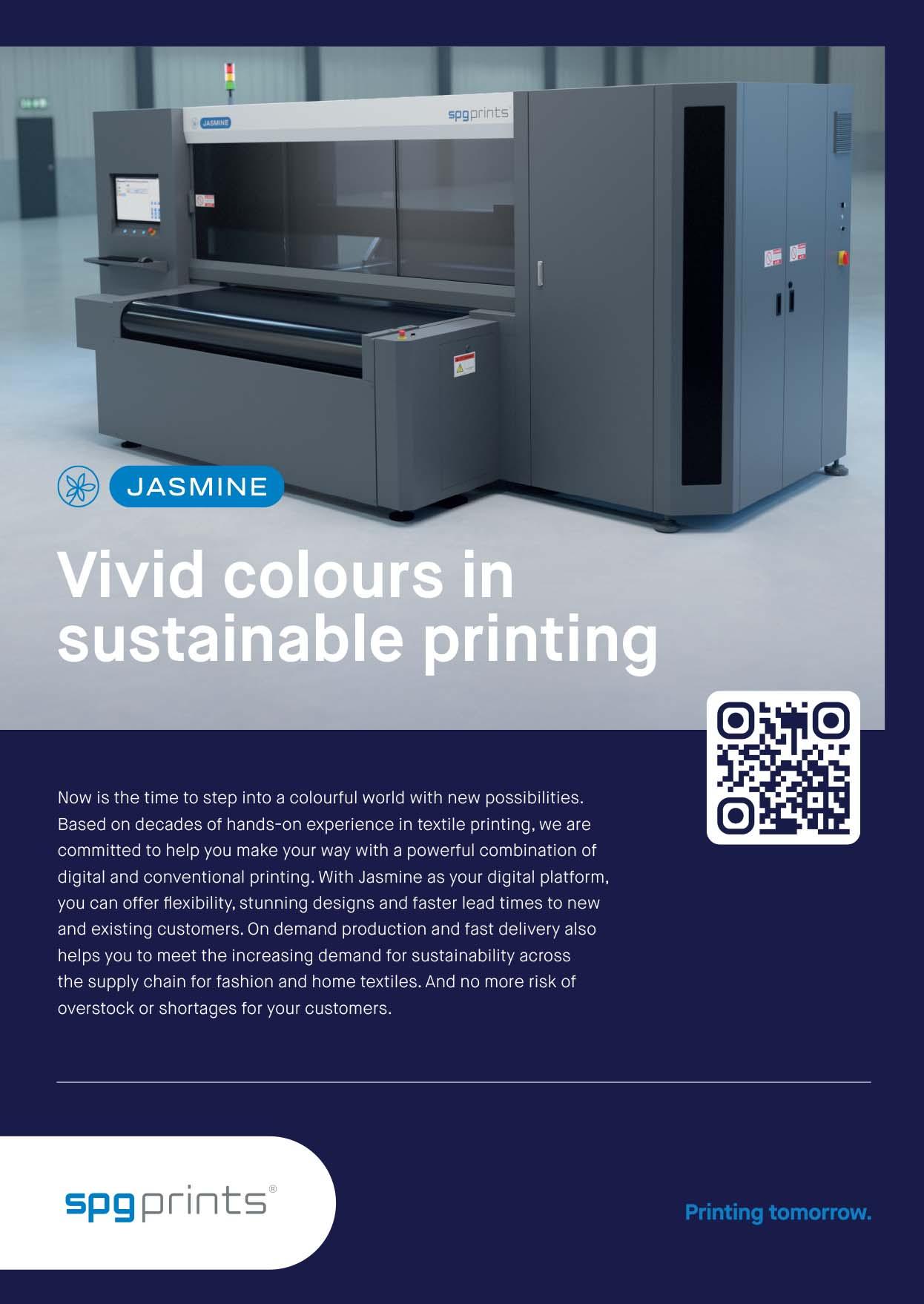



























































































 Dr. Muhammad Qasim Siddiqui
Dr. Muhammad Qasim Siddiqui






































































